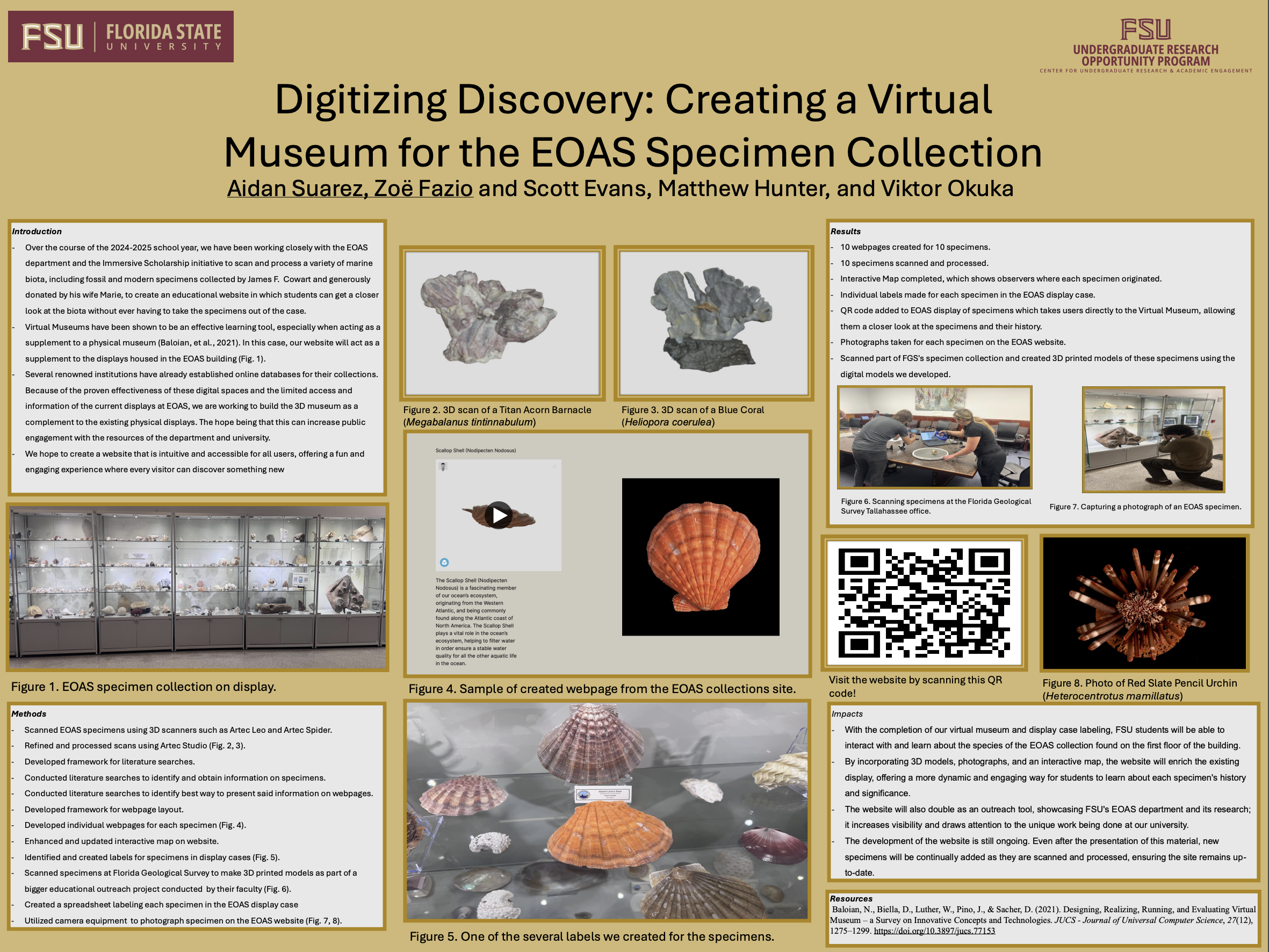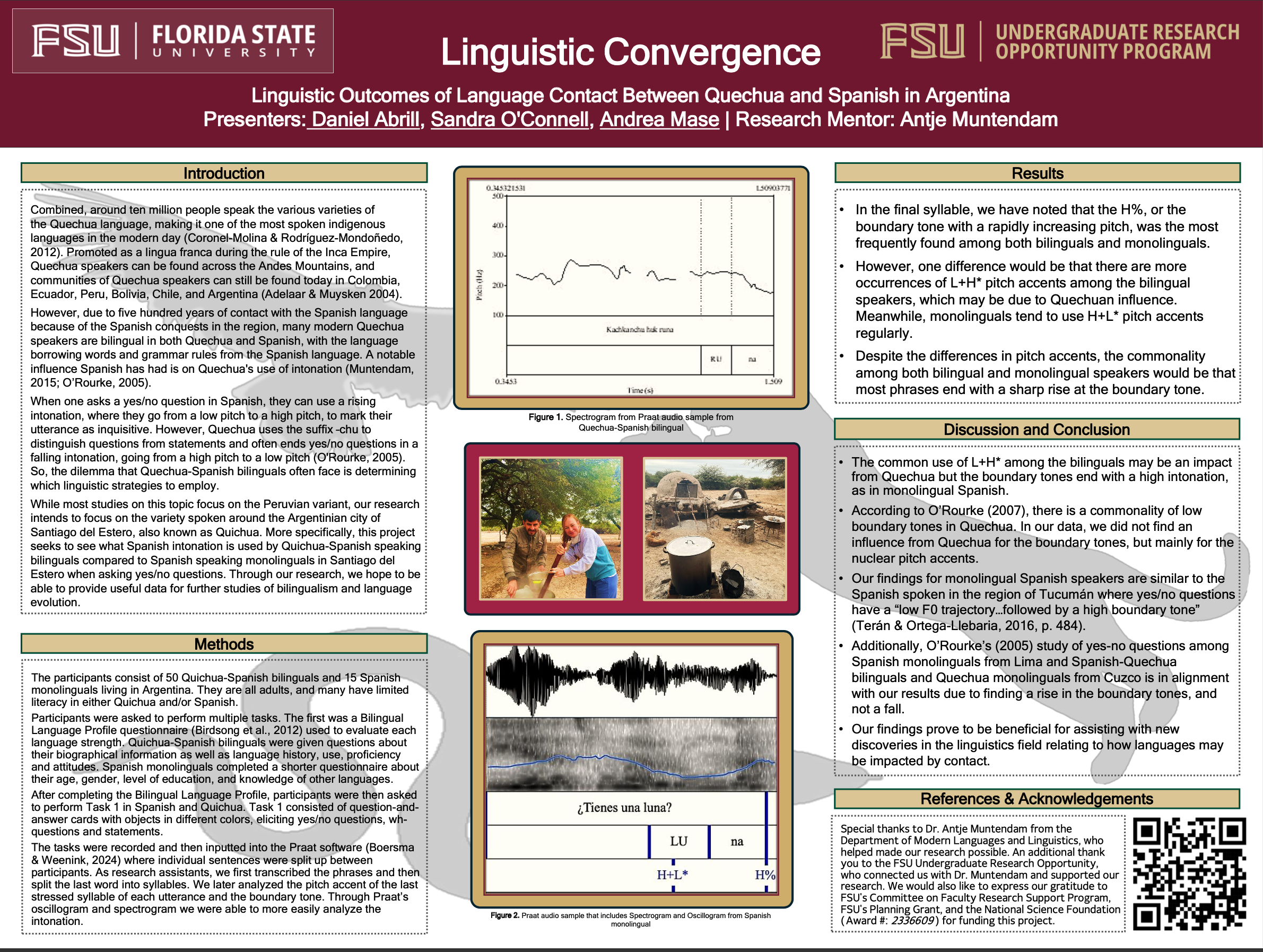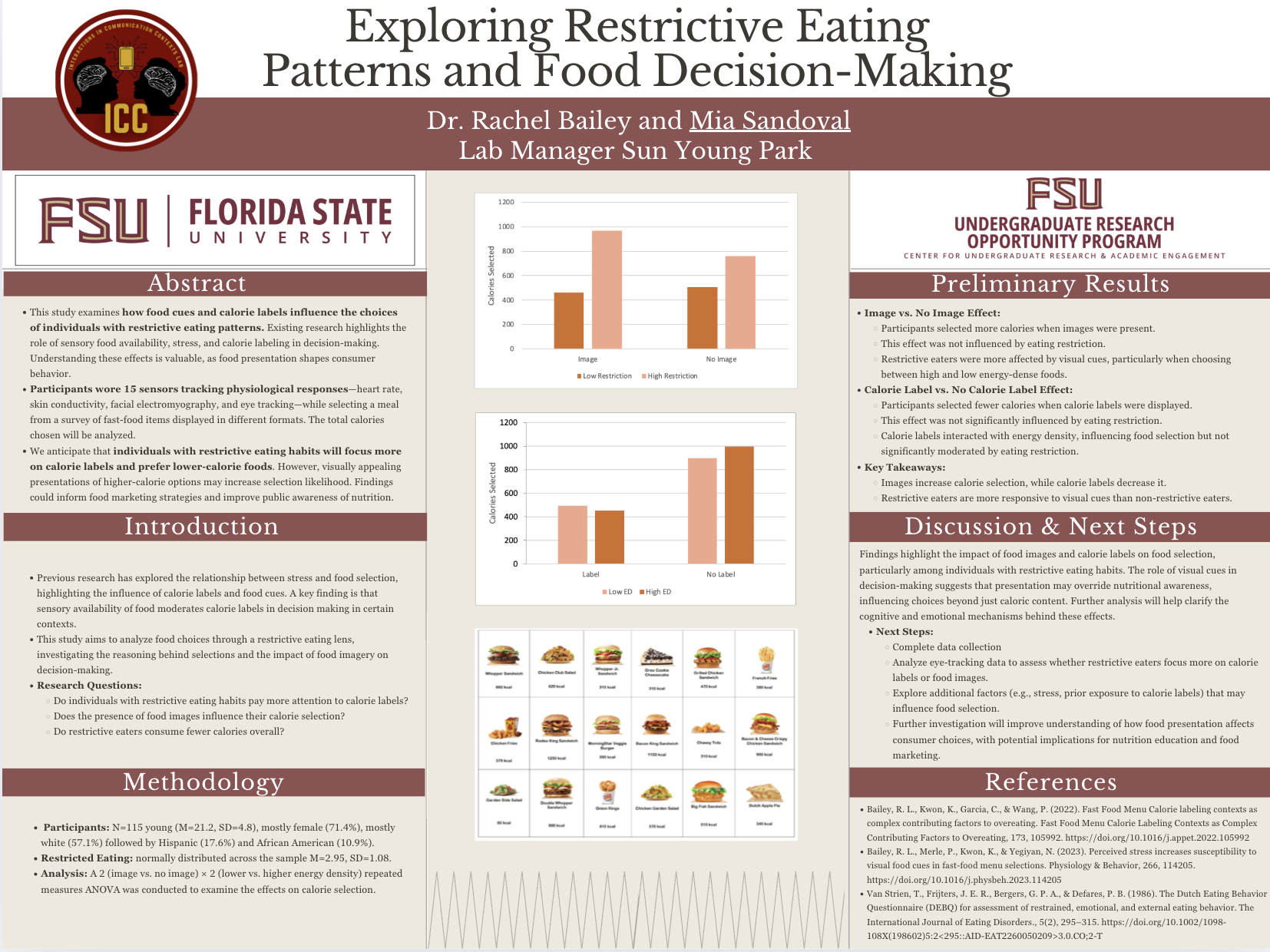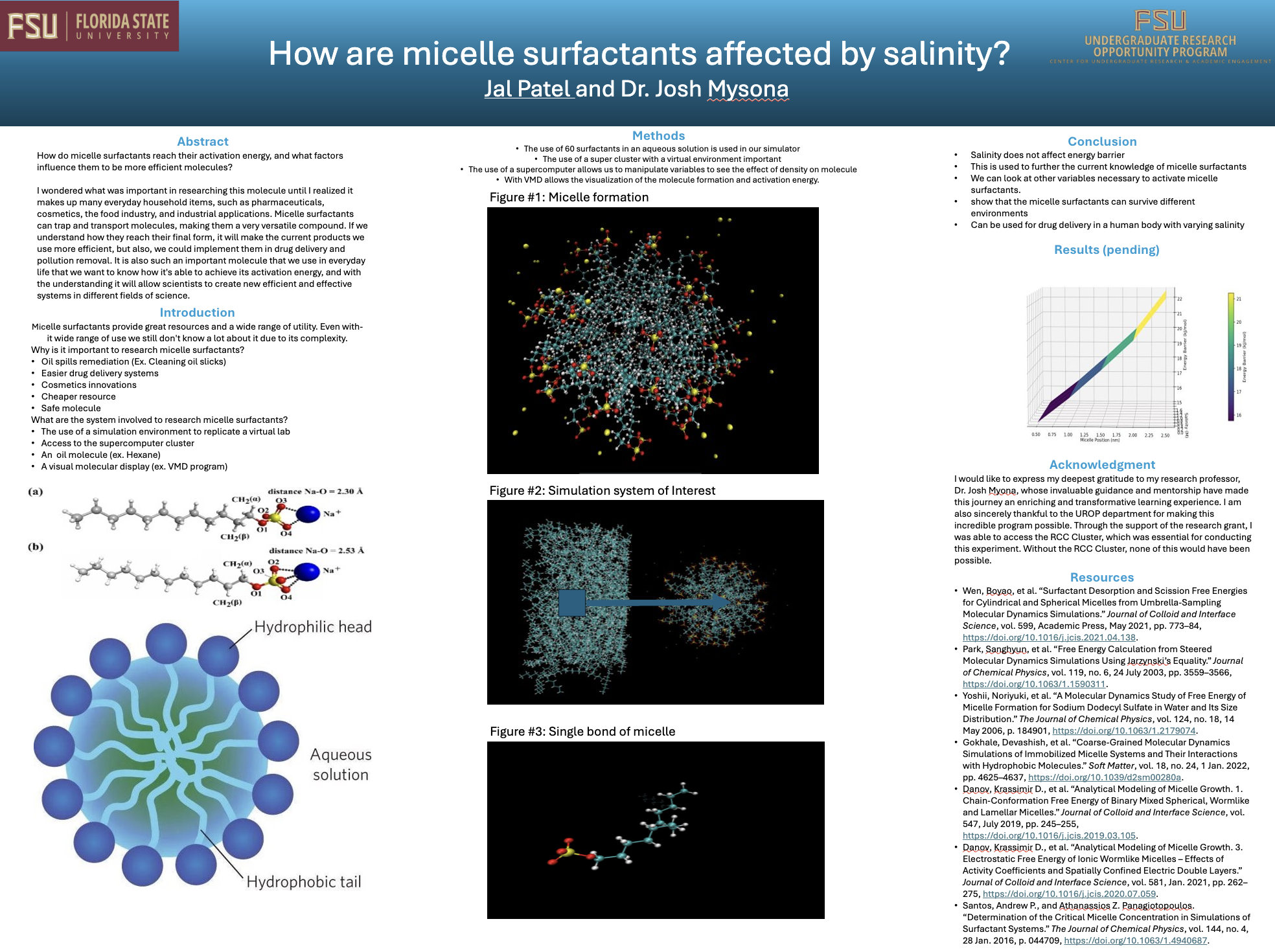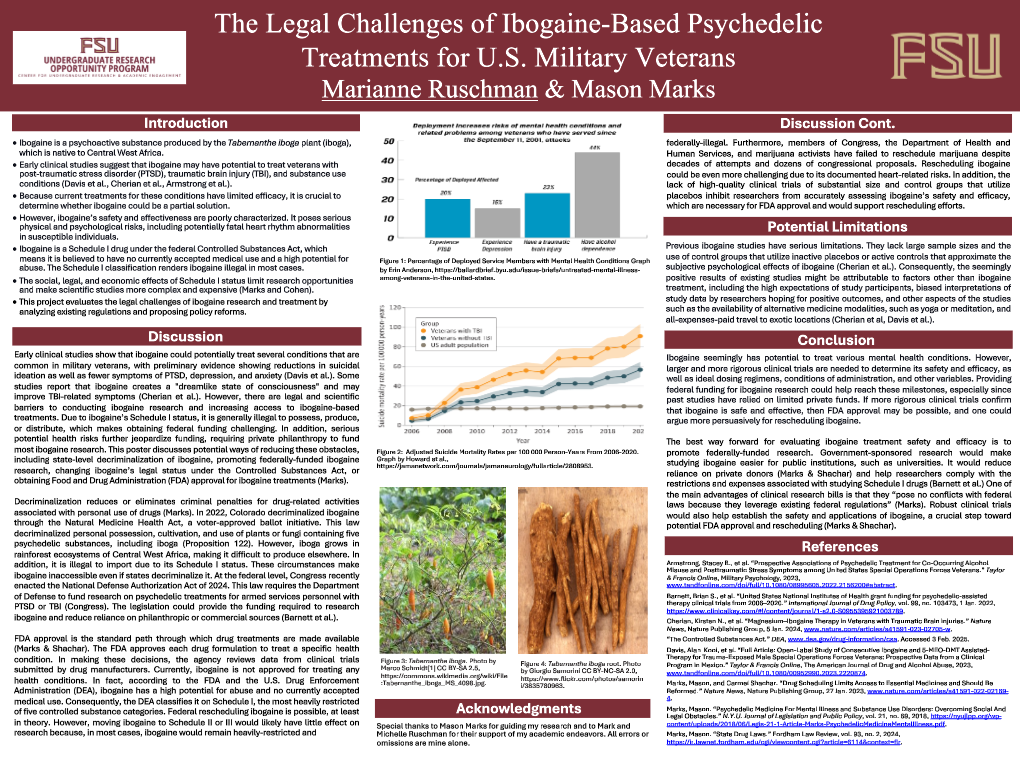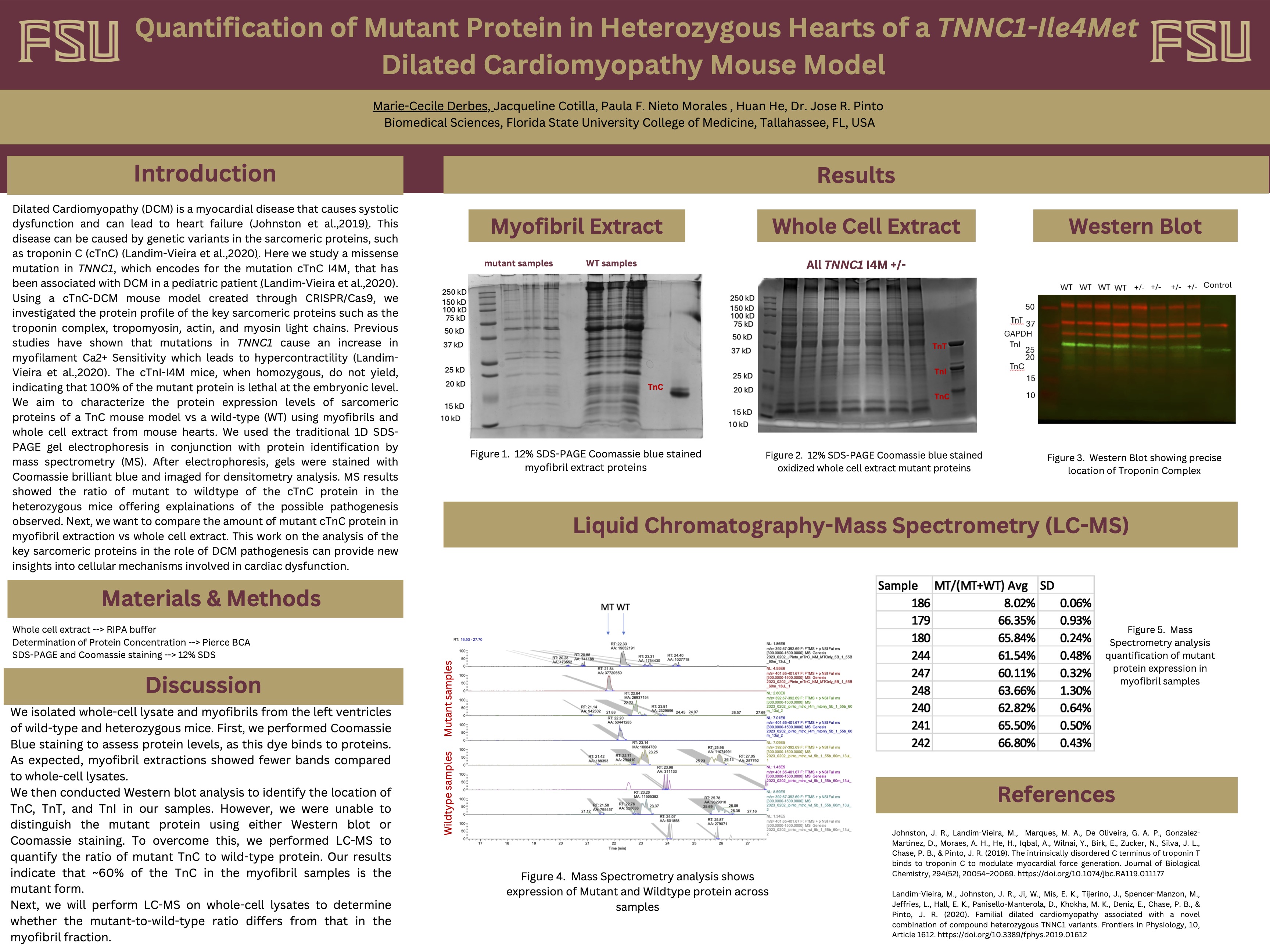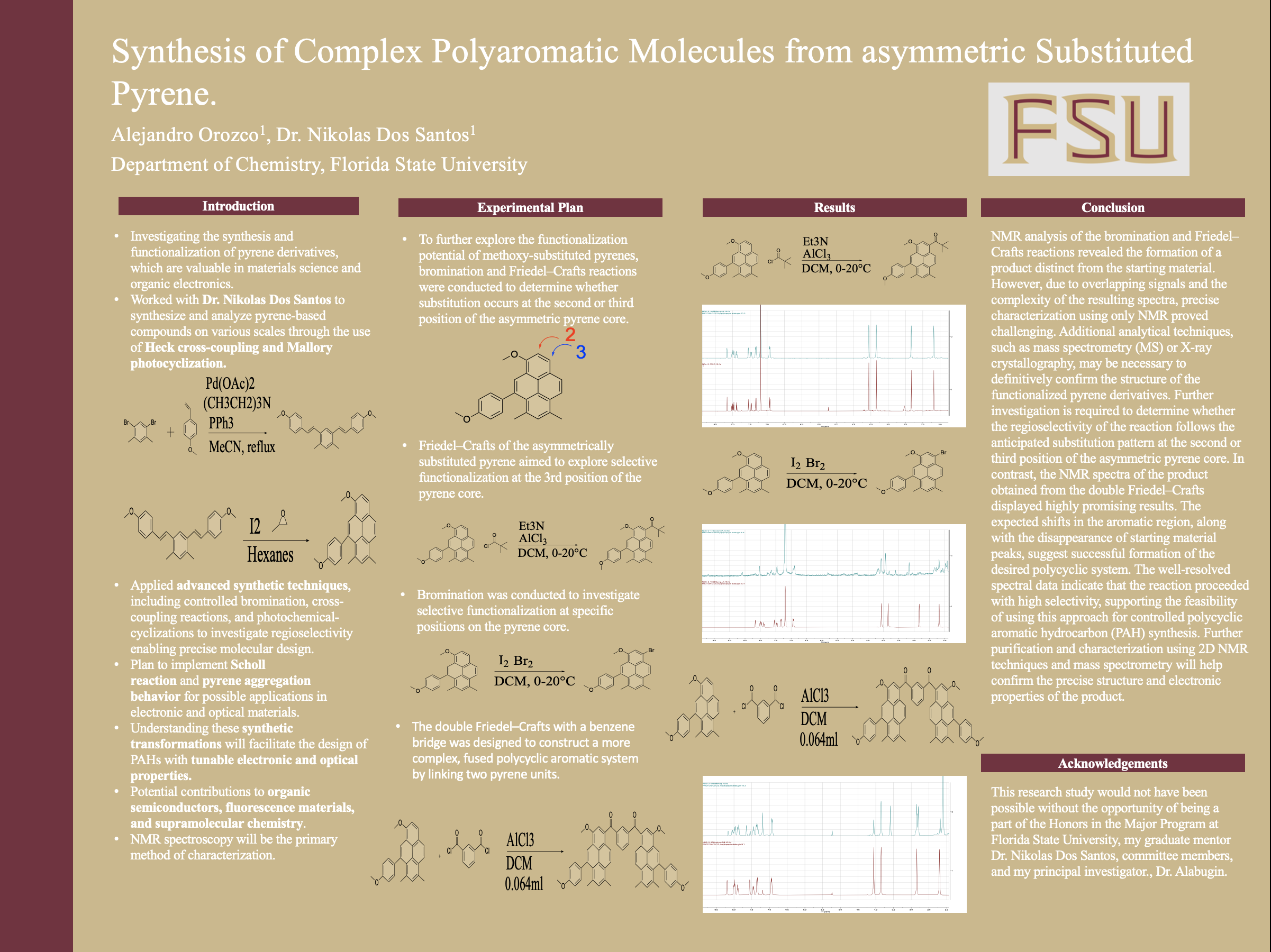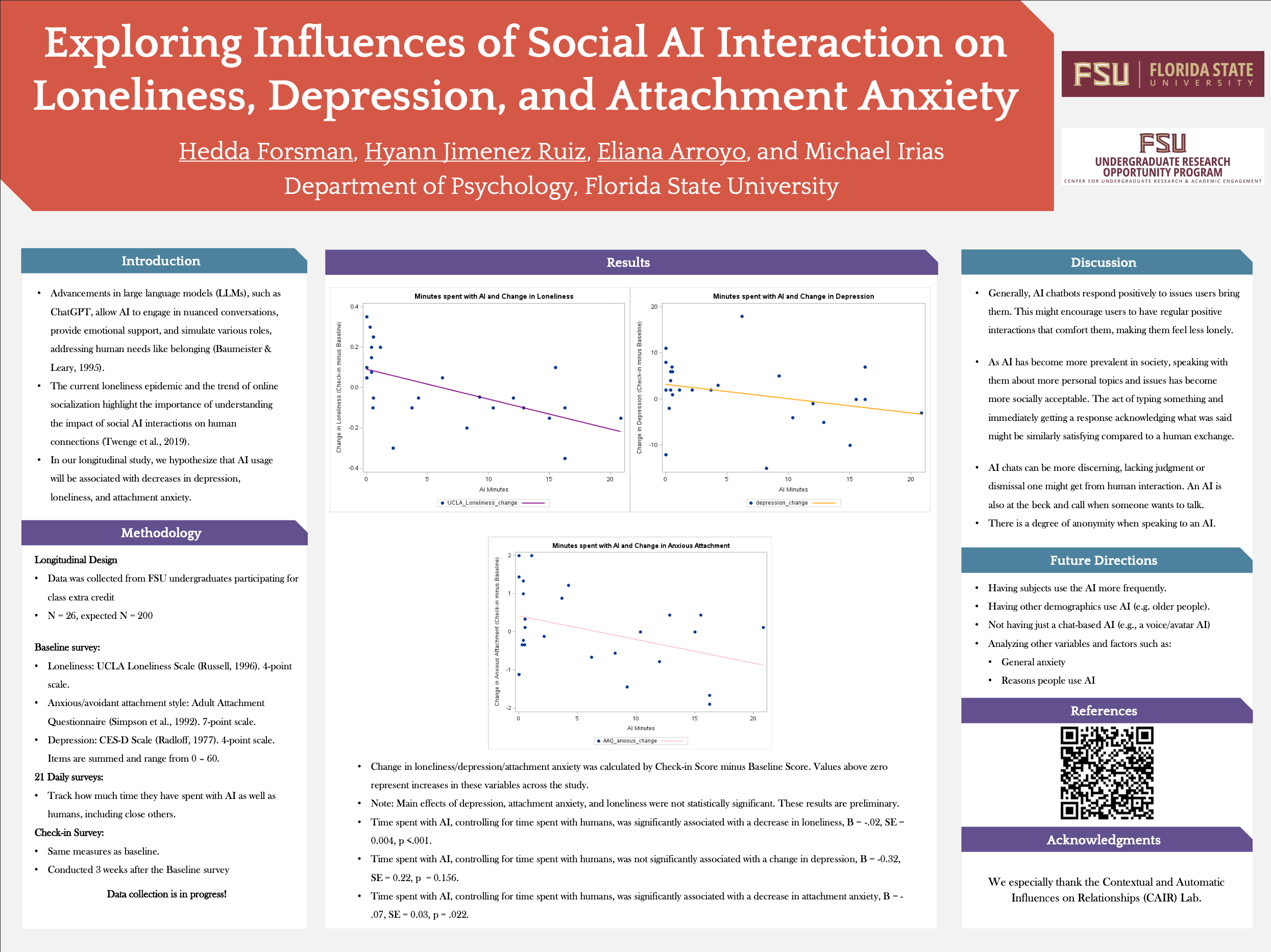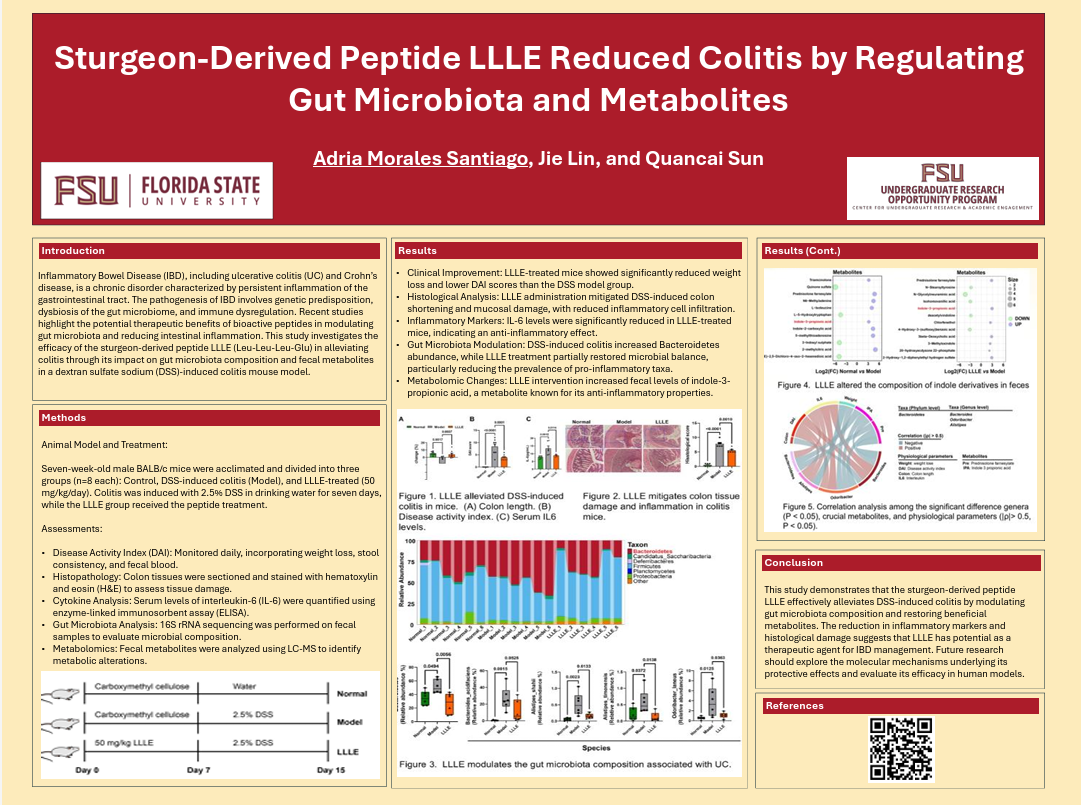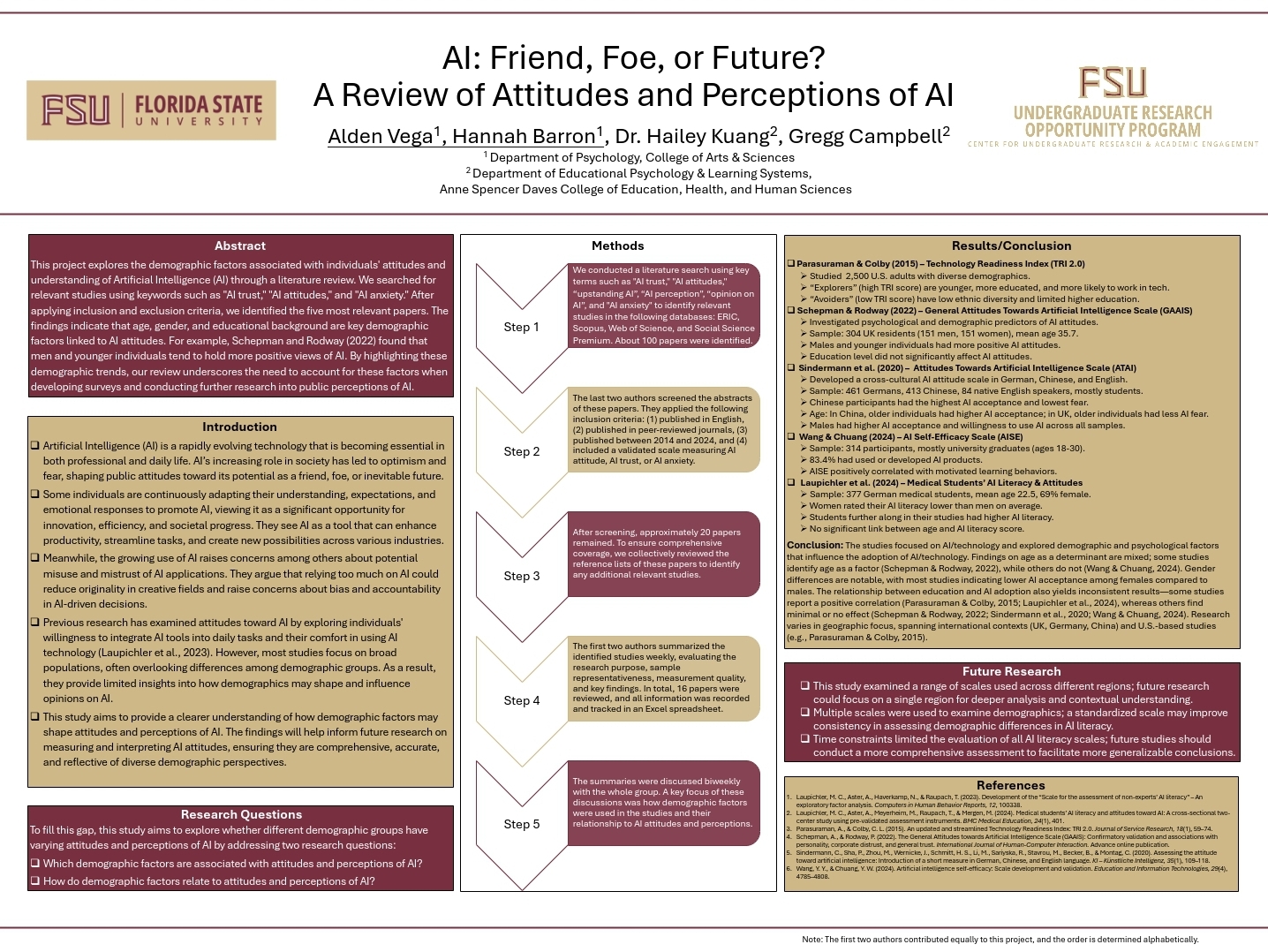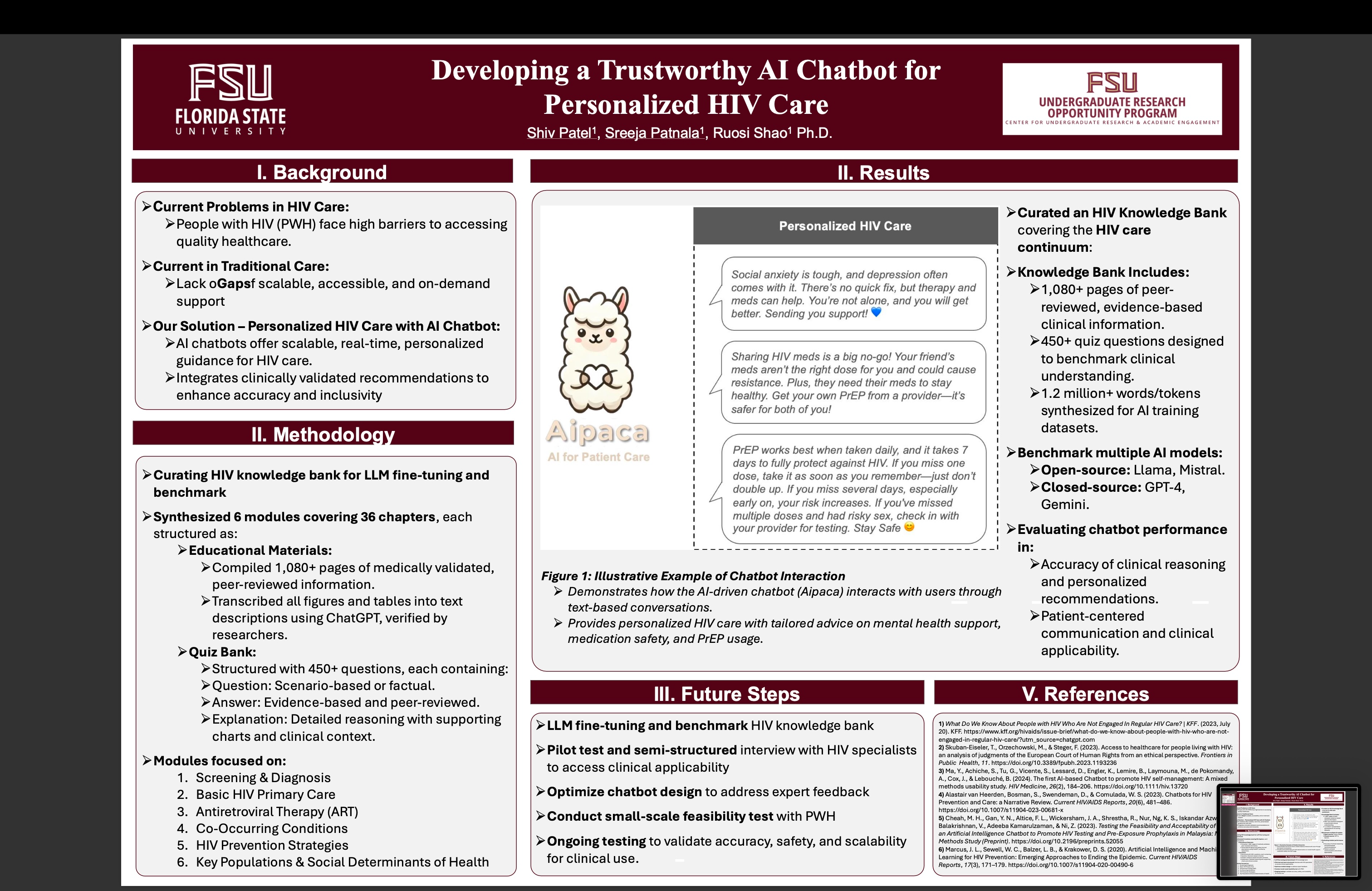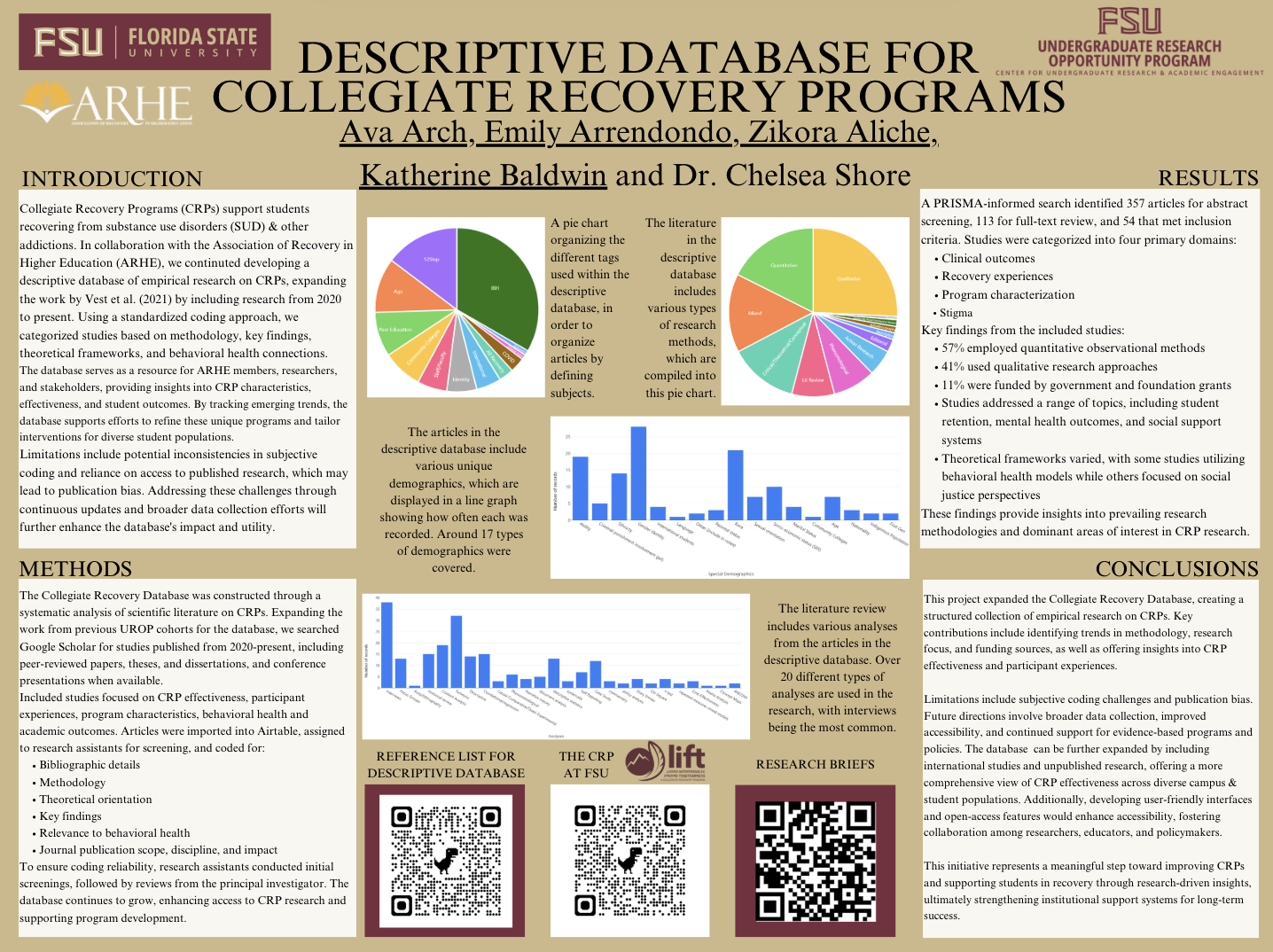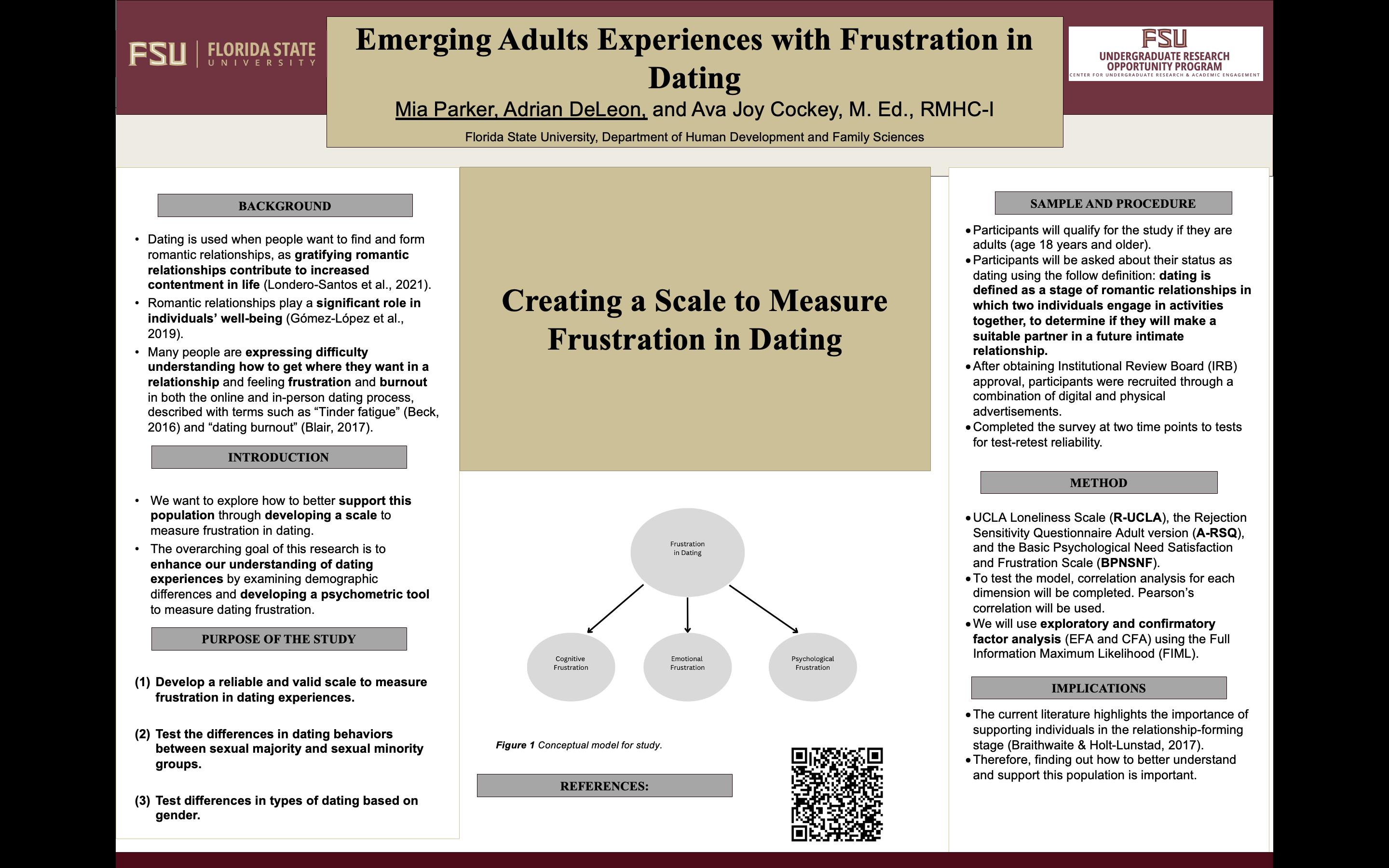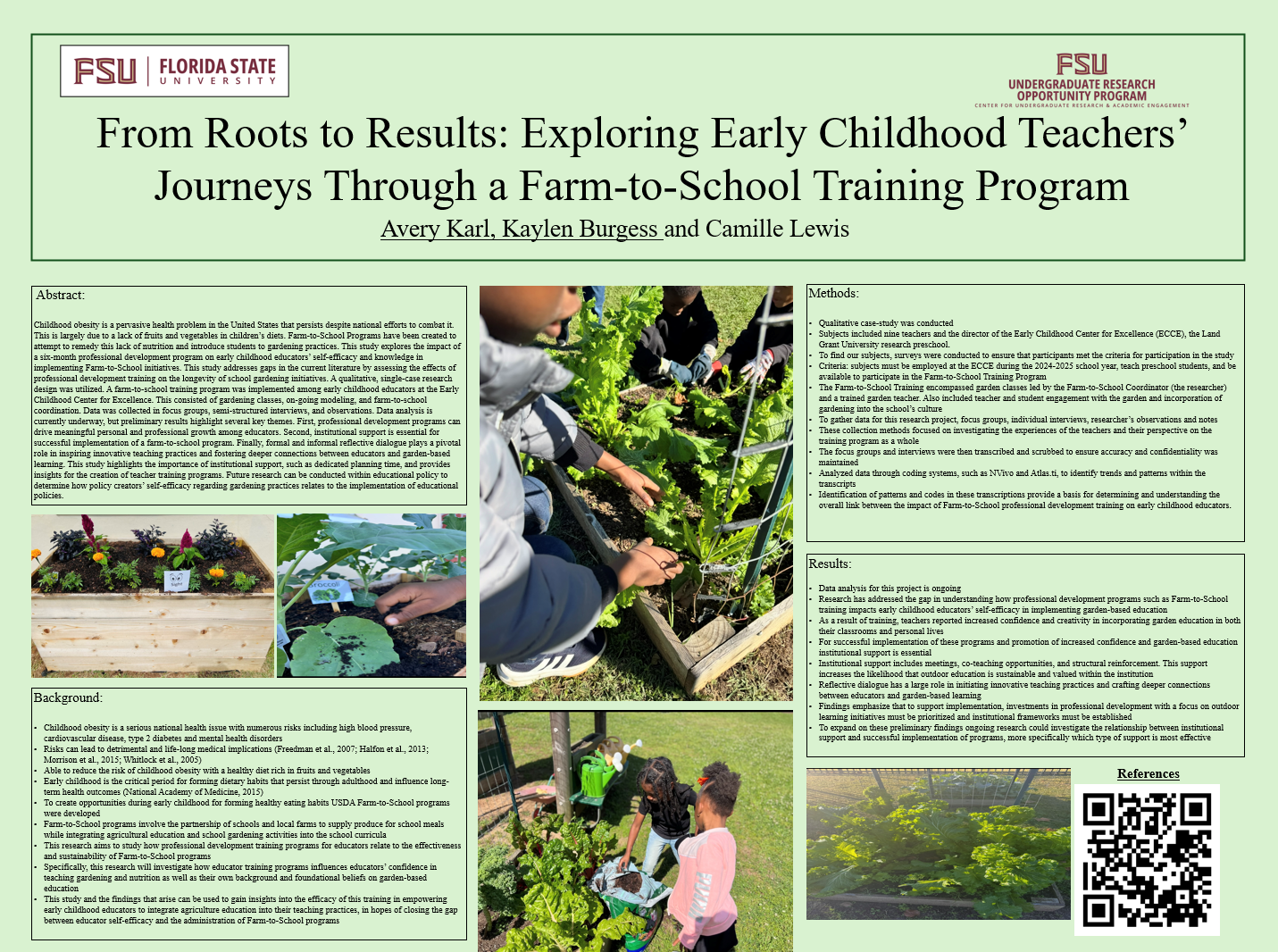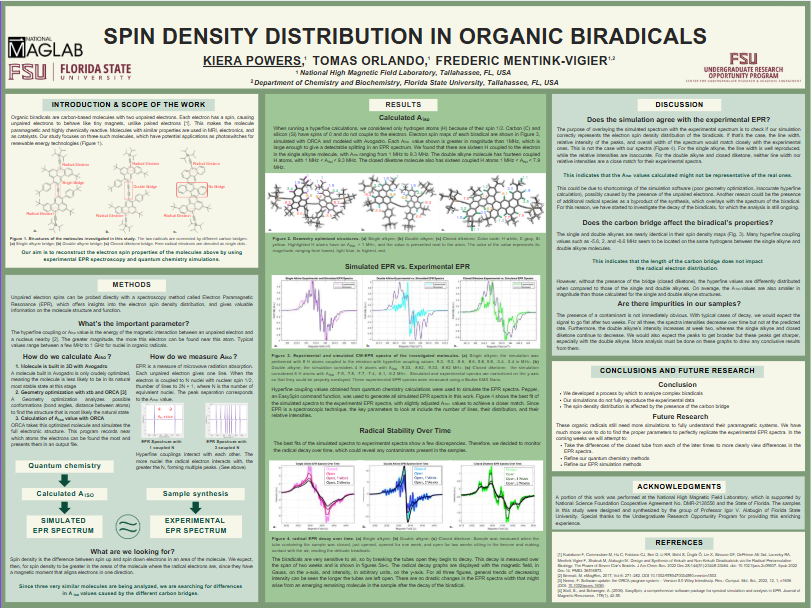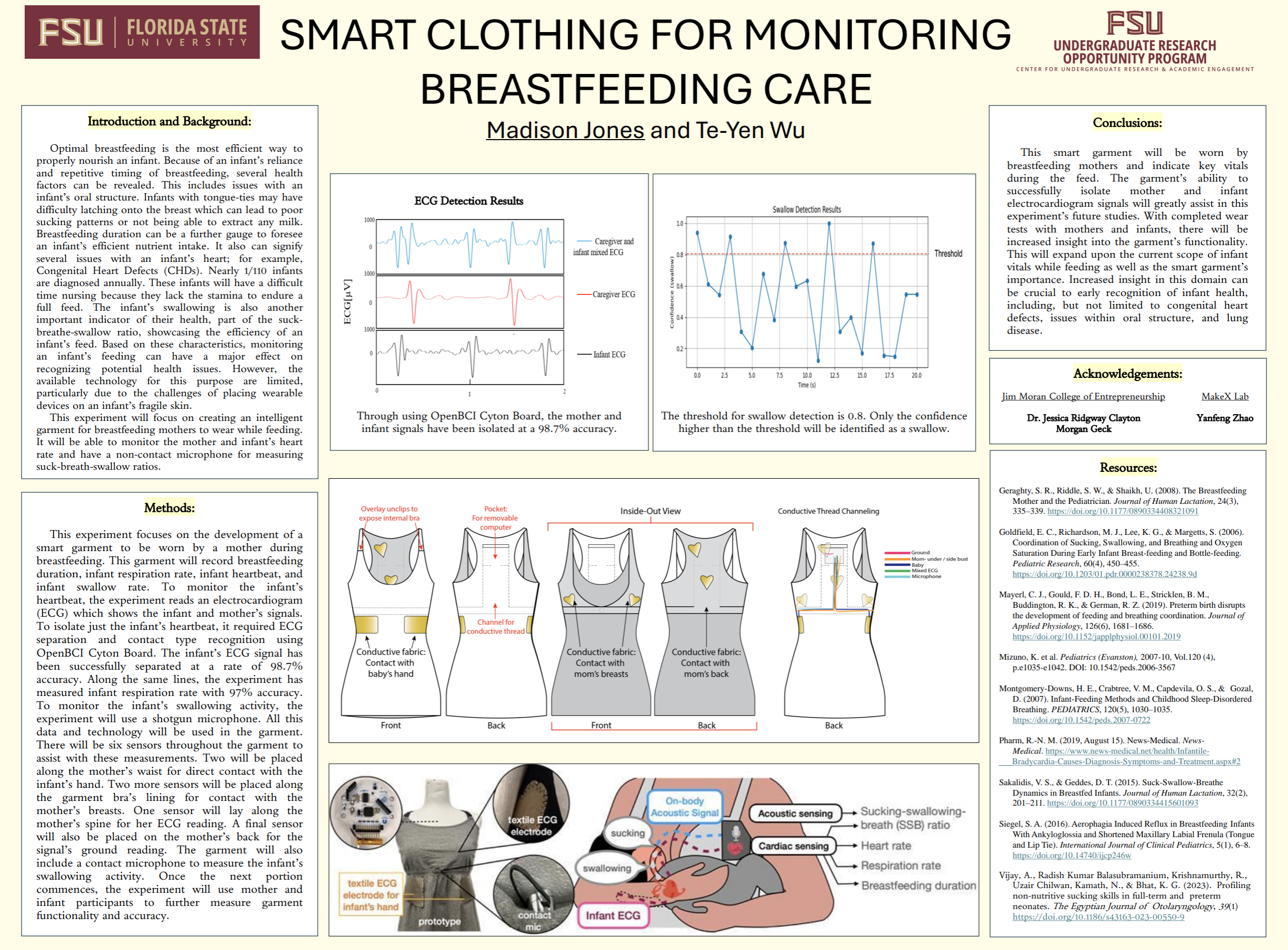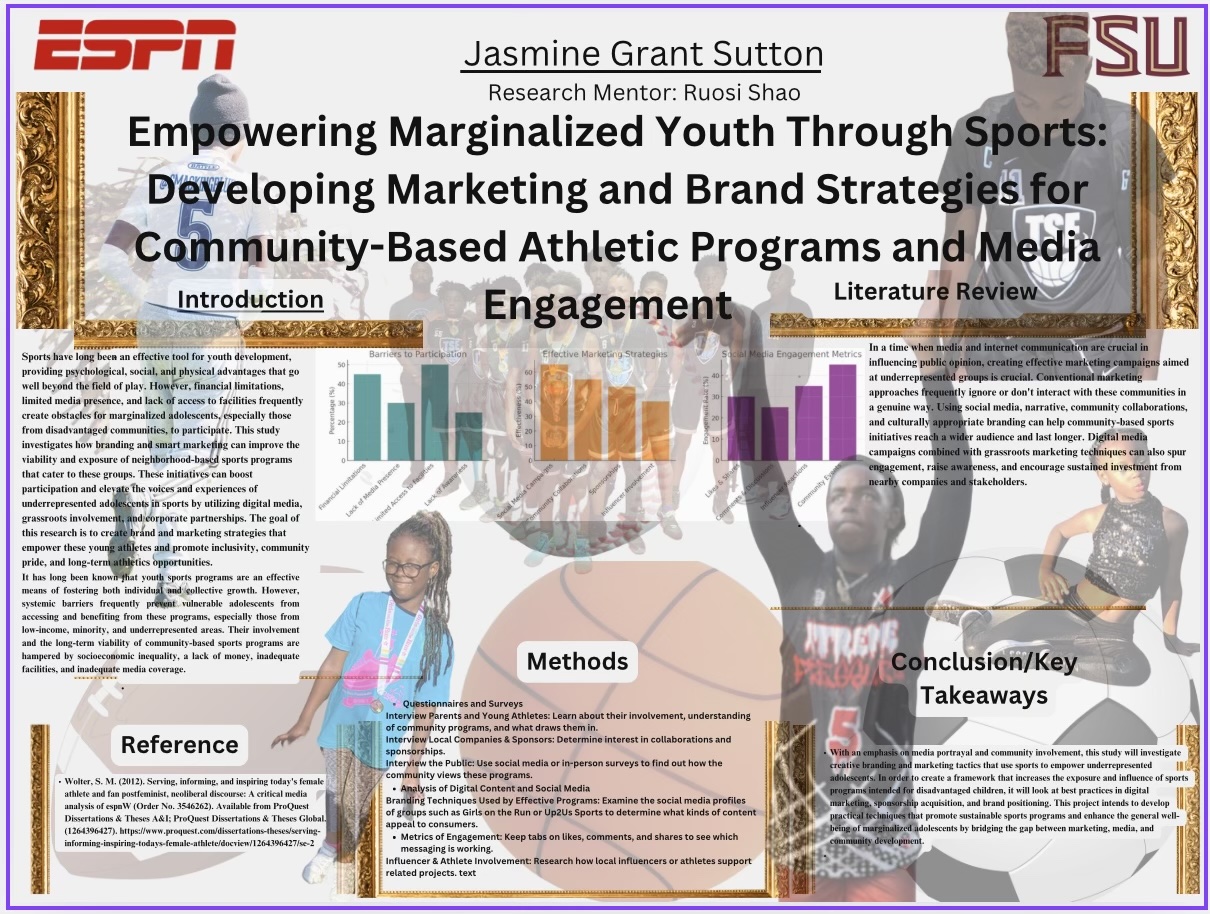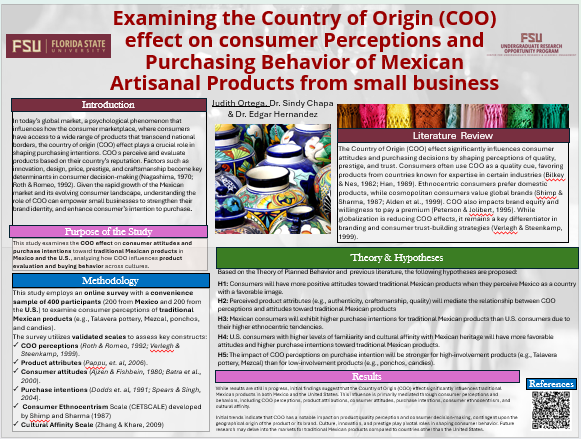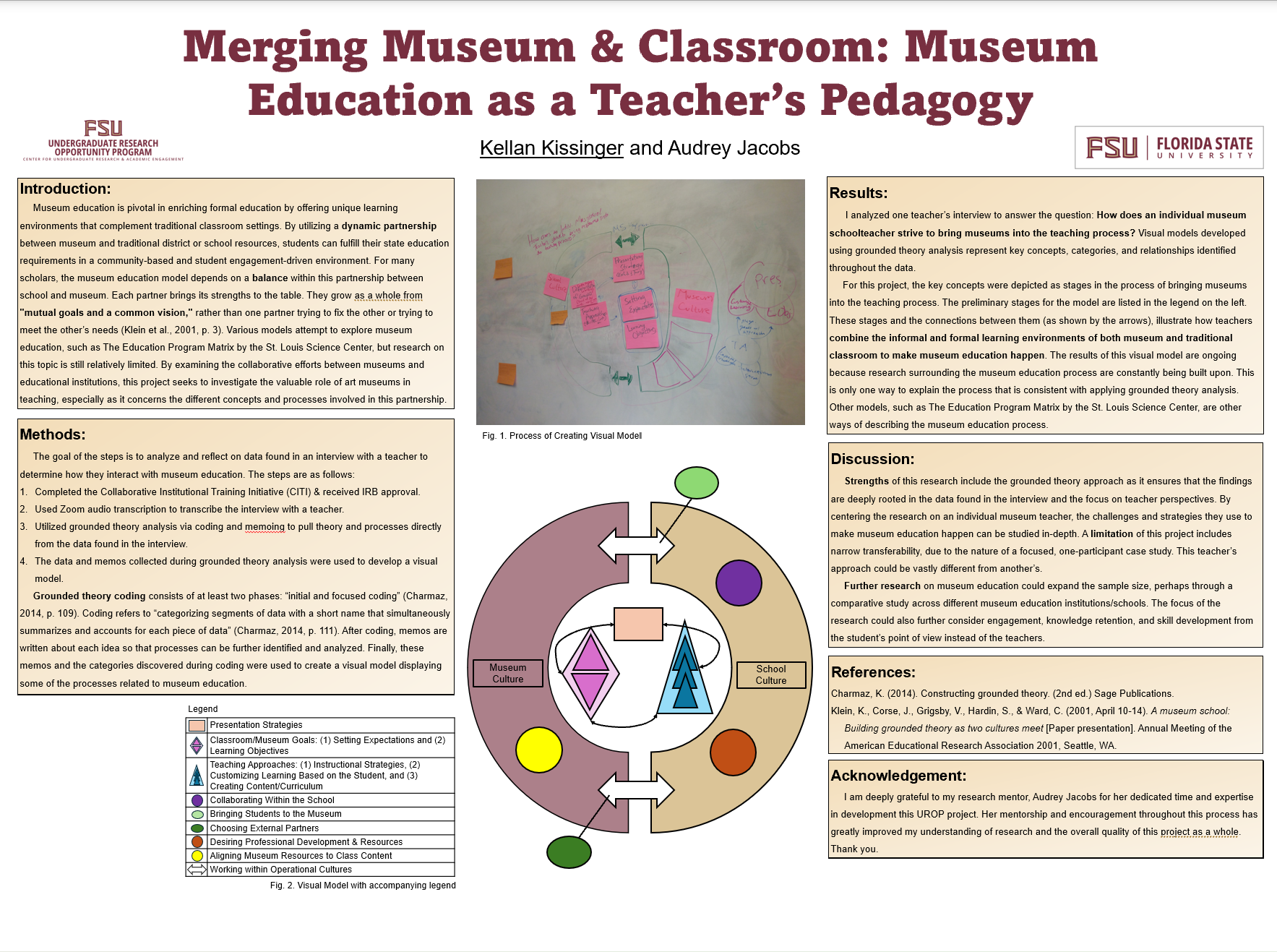Research Symposium
25th annual Undergraduate Research Symposium, April 1, 2025
Zoe Fazio Nourishing Creativity/Poster Session 3: 1:45 pm - 2:45 pm/ Poster #266
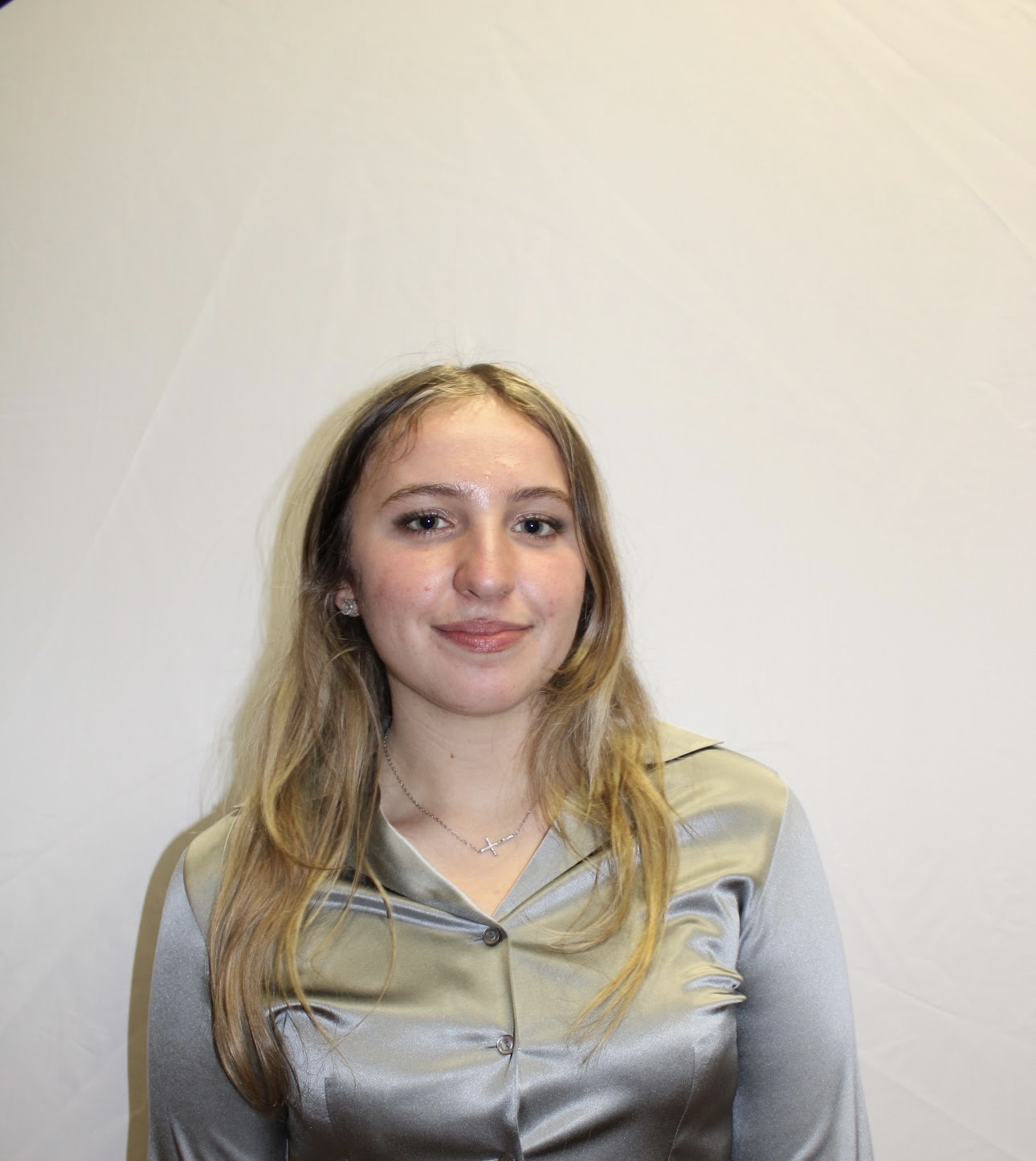
BIO
My name is Zoe Fazio, and I am from Fort Lauderdale, Florida. I am interested in research in Geology and Paleontology, and plan to continue my education after undergraduate, with the hope of obtaining my PhD and becoming a professor.
Digitizing Discovery: Creating a Virtual Museum for the EOAS Specimen Collection
Authors: Zoe Fazio, Scott EvansStudent Major: Environmental Science and Policy
Mentor: Scott Evans
Mentor's Department: Earth, Ocean, & Atmospheric Science Mentor's College: College of Arts and Sciences Co-Presenters: Aidan Suarez
Abstract
The goal of our project is to create a virtual museum for the specimens of the Cowart collection, which are displayed in the halls of the EOAS building. We aim to make information about these specimens more accessible to any and all FSU students and other visitors. To accomplish this goal, we conducted literature searches to correctly identify and obtain information on each specimen. We also produced digital scans of select specimens using Artec Leo and Space Spider 3D scanners. This combined dataset was used to build a complementary website, through programs such as Adobe Illustrator and WordPress. By the end of the project, we expect to have developed 10-15 webpages for specimens housed in the virtual museum. In completing this project, we will have created an educational outreach tool, allowing students and anyone who walks into the EOAS building an opportunity to access information that otherwise would not have been directly available. An additional aim of the project is to bring attention to the EOAS department's research and education efforts.
Keywords: virtual museum, digital collection, marine specimens, fossils
25th annual Undergraduate Research Symposium, April 1, 2025
Andrea Mase Poster Session 3: 1:45 pm - 2:45 pm/ Poster #259
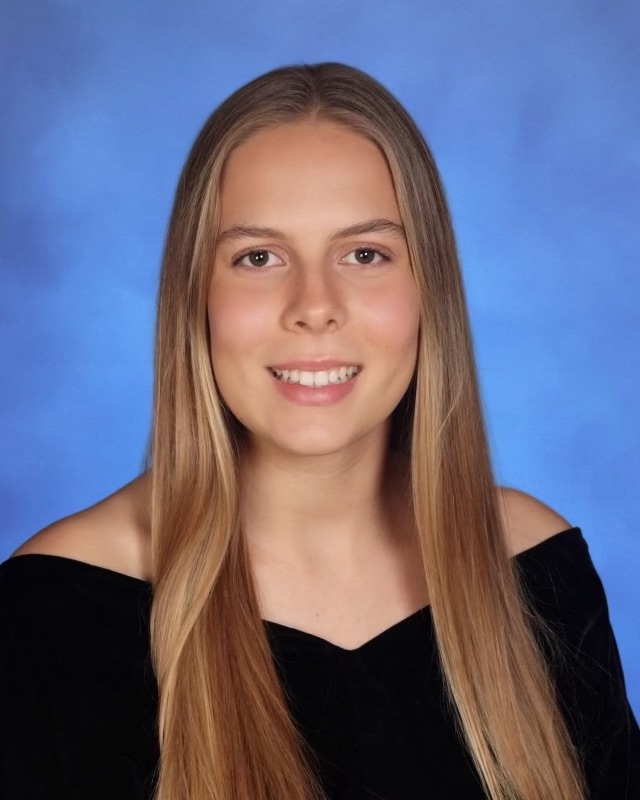
BIO
I am an Honors undergraduate freshman from Miami studying Marketing in the College of Business. I am eager to explore career paths in commercial real estate, marketing, and international business, where I can combine my passion for people and global markets. This year, I have had the privilege to analyze how Quechua, one of the most popular Native American languages, and Spanish interact linguistically in Argentina. I found this project particularly interesting due to my Argentinian background.
Linguistic Convergence: Linguistic Outcomes of Language Contact Between Quechua and Spanish in Argentina
Authors: Andrea Mase, Antje MuntendamStudent Major: Marketing
Mentor: Antje Muntendam
Mentor's Department: Department of Modern Languages and Linguistics Mentor's College: College of Arts and Sciences Co-Presenters:
Abstract
This project intends to study the linguistic outcome of language contact between Quechua and Spanish in Argentina. When Spanish speakers ask yes-no questions, they use a rising intonation, while Quechua uses a falling intonation and the marker -chu. However, due to centuries of intense contact between the two languages, bilingual Quechua-Spanish speakers may be accustomed to using intonation in both languages or in neither. Thus, the question this project seeks to answer is what intonation bilinguals and monolinguals utilize in Santiago del Estero, Argentina. For this research project, audio samples were collected from this region from 26 bilingual Quechua-Spanish speakers and 15 monolingual Spanish speakers in which the participants were asked to play a card game where they would ask each other yes/no- questions. As research assistants, we analyzed these audio samples in the platform Praat to view the type of intonation. The results we found so far reveal that most bilingual speakers tend to continue to use rising intonation in Spanish at the end of the questions, although there are some differences between monolinguals and bilinguals in nuclear pitch accents (i.e., the tone on the stressed syllable of the last word). In Quechua, most speakers do not use the marker -chu and use a rising intonation as in Spanish instead. Variation among participants is found, which can be explained based on language use and language attitudes. This study furthers bilingualism research in Argentina, which is underexplored, and adds onto existing theories on language evolution and effects of language contact.
Keywords: Linguistics, Argentina, Native American languages, Spanish, Quechua
25th annual Undergraduate Research Symposium, April 1, 2025
Isabella Carrerou Poster Session 3: 1:45 pm - 2:45 pm/ Poster #114

BIO
I am a second-year student at FSU from South Florida. My project focuses on AI-assisted image analysis for the structural characterization of HIV-1 capsids. Through this research, I have gained experience in image processing, data analysis, and machine learning applications in biomedical science. I am particularly interested in how computational methods can enhance our understanding of complex biological structures. Engaging in research has strengthened my analytical skills and curiosity, and I look forward to continuing to explore new techniques and applications in the field.
AI-Assisted Image Analysis for Structural Characterization of HIV-1 Capsids
Authors: Isabella Carrerou, Ashwanth FrancisStudent Major: Public Health
Mentor: Ashwanth Francis
Mentor's Department: Institute of Molecular Biophysics Mentor's College: College of Arts and Sciences Co-Presenters:
Abstract
Cryo-Electron Microscopy (Cryo-EM) is a powerful tool for studying the structural characteristics of the HIV-1 capsid within its cellular environment. However, limitations such as low signal-to-noise ratio (SNR) and the complex identification of capsids in crowded environments hinder accurate segmentation and analysis. To address these challenges, this project integrates artificial intelligence (AI) with Cryo-EM to automate capsid detection and classification. Using convolutional neural networks (CNNs) and advanced image segmentation techniques, this approach enhances accuracy, reduces human bias, and accelerates analysis. Results demonstrate improved capsid identification and reduced image processing time, aligning with previous research supporting AI-driven image analysis. Future work will focus on optimizing training datasets and expanding AI applications to additional imaging techniques and biological samples, further advancing structural virology research in HIV-1.
Keywords: Segmentation, AI, HIV-1
25th annual Undergraduate Research Symposium, April 1, 2025
Mia Sandoval Poster Session 2: 10:45 am - 11:45 am/ Poster #194
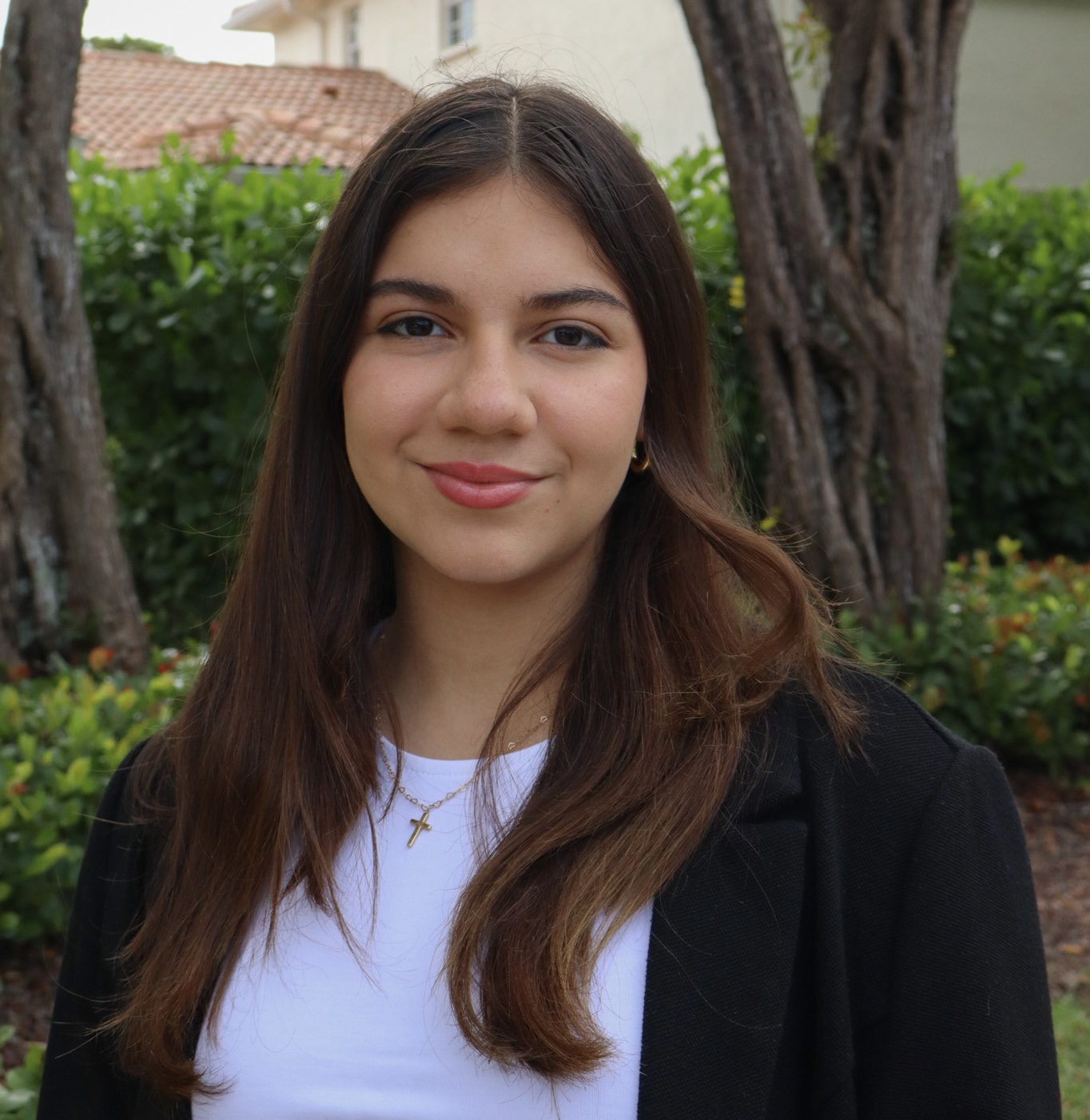
BIO
I am from Guaynabo, Puerto Rico, majoring in Food and Nutrition Science and Dietetics. My research interests include the gut microbiome, restrictive eating, and orthorexia.
Exploring Restrictive Eating Patterns and Food Decision-Making
Authors: Mia Sandoval, Dr. Rachel BaileyStudent Major: Food and Nutrition Science, Dietetics
Mentor: Dr. Rachel Bailey
Mentor's Department: School of Communication Mentor's College: College of Communication & Information Co-Presenters:
Abstract
This research project examines how food cues and calorie labels impact the food choices of individuals with restrictive eating patterns (i.e., dieting or avoiding certain foods to avoid weight gain). Existing literature on this topic explores the sensory availability of food, the role of stress in food decision-making, and the influence of calorie labels on selections. Investigating whether and how calorie labeling is effective is valuable, as the way food is presented can significantly affect consumer reactions and decision-making. In this study, participants are equipped with 15 sensors that collect physiological data, including heart rate, skin conductivity, facial electromyography, and eye tracking. These metrics index cognitive and emotional processing of the menu information. These data are gathered while participants complete a survey displaying an array of food items from popular fast-food chains in different formats. Each participant is asked to select a typical meal, with the option to choose multiple items but required to select at least one. The amount of calories selected for each typical meal will be analyzed as well. While data collection is still ongoing, we anticipate that individuals with restrictive eating habits will pay greater attention to calorie labels and be more likely to choose foods with lower energy density, or fewer calories per bite. However, we also expect that the visual presentation of lower energy-density foods may decrease the likelihood of selection. These findings have important implications for how food is marketed to consumers and for enhancing public awareness of food choices and nutritional knowledge.
Keywords: food, restrictive eating, food decision, calorie
25th annual Undergraduate Research Symposium, April 1, 2025
JAL PATEL Poster Session 2: 10:45 am - 11:45 am/ Poster #149
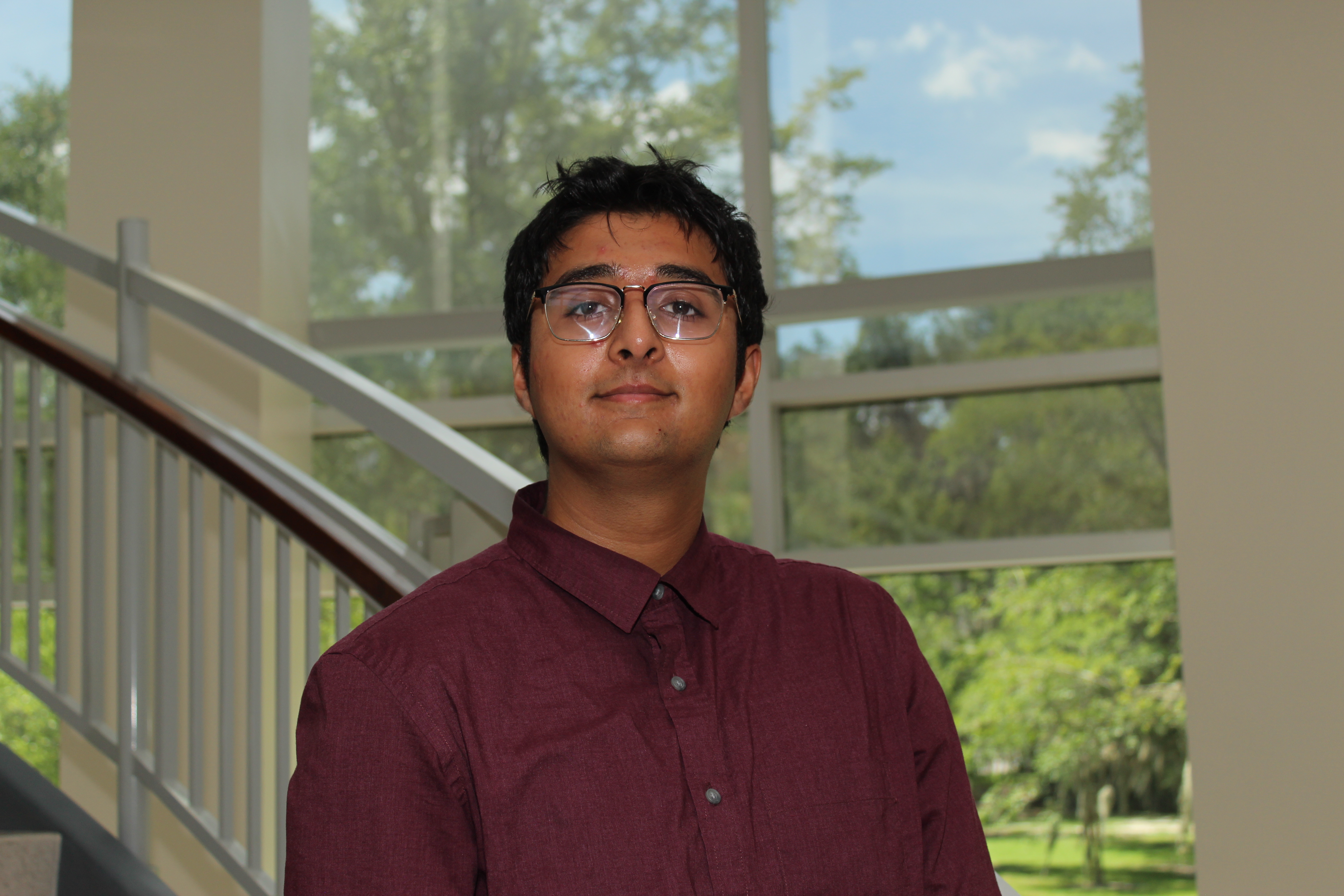
BIO
Hello, my name is Jal Patel, and I’m from Celebration, Florida.
For my UROP project, I investigated how salinity impacts micelle surfactants. Using our university’s high-performance computing resources, I analyzed how different salt concentrations affect the structure and behavior of micelles. This research contributes to a deeper understanding of surfactant behavior, which has potential applications in environmental remediation—such as addressing oil spills.
Through UROP, I gained hands-on experience in computational research, which I plan to build on through further undergraduate research. I aim to pursue a Ph.D. and eventually start my own research company focused on advancing healthcare solutions.
How are micelle surfactants affected by salinity?
Authors: JAL PATEL, Dr. Josh MysonaStudent Major: Biomedical engineering
Mentor: Dr. Josh Mysona
Mentor's Department: COE Mentor's College: FSU-FAMU College of Engineering Co-Presenters:
Abstract
How do micelle surfactants reach their activation energy, and what factors influence them to be more efficient molecules?
I wondered what was important in researching this molecule until I realized it makes up many everyday household items, such as pharmaceuticals, cosmetics, the food industry, and industrial applications. Micelle surfactants can trap and transport molecules, making them a very versatile compound. If we understand how they reach their final form, it will make the current products we use more efficient, but also, we could implement them in drug delivery and pollution removal. It is also such an important molecule that we use in everyday life that we want to know how it's able to achieve its activation energy, and with the understanding it will allow scientists to create new efficient and effective systems in different fields of science.
Keywords: Chemical engineering, micelle surfactants
25th annual Undergraduate Research Symposium, April 1, 2025
Marianne Ruschman Poster Session 3: 1:45 pm - 2:45 pm/ Poster #178
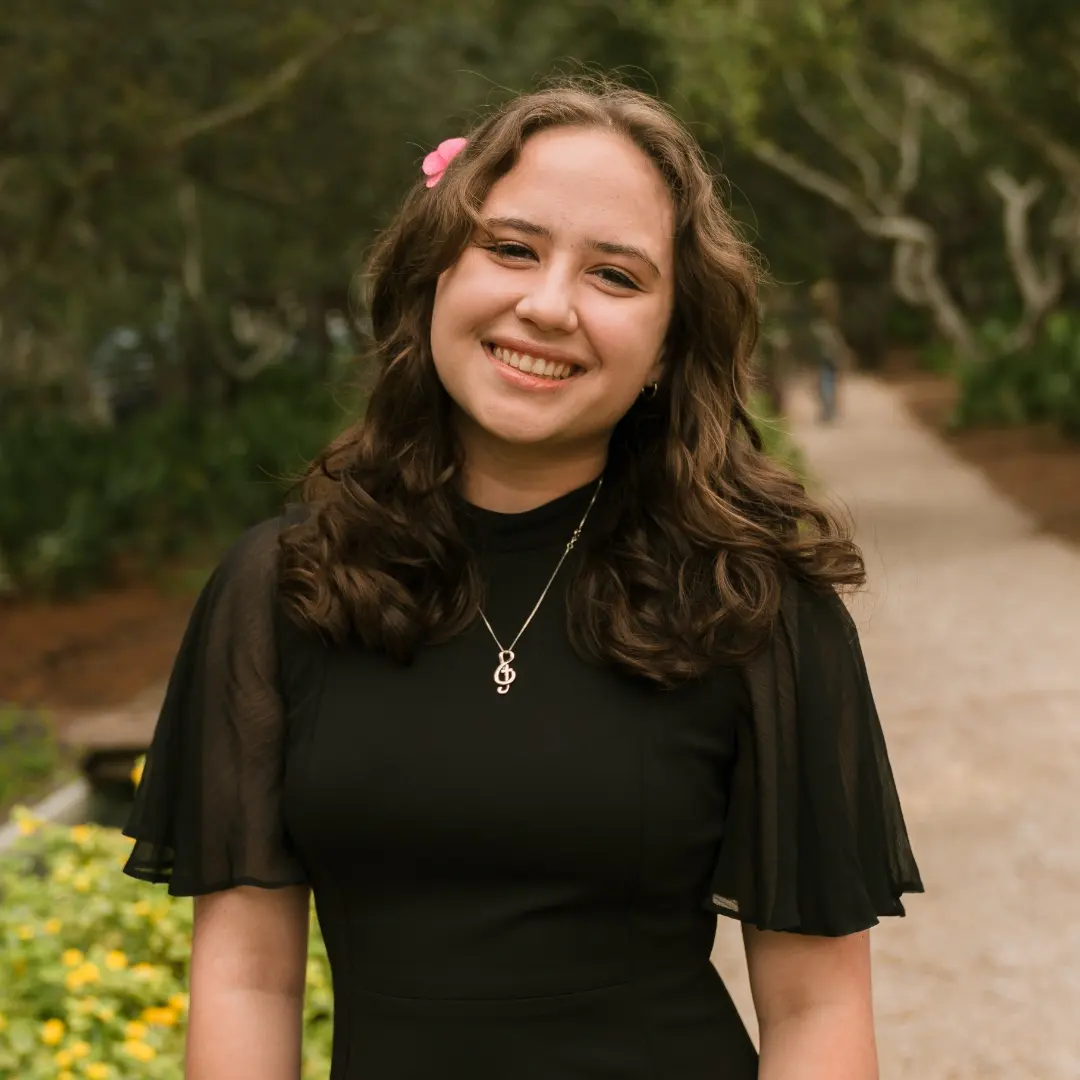
BIO
Marianne Ruschman is a Presidential Scholar from Niceville, Florida, and she is currently pursuing a degree in Criminology with a double major in Philosophy.
The Legal Challenges of Ibogaine-Based Psychedelic Treatments for U.S. Military Veterans
Authors: Marianne Ruschman, Mason Marks, MD, JDStudent Major: Criminology, Philosophy
Mentor: Mason Marks, MD, JD
Mentor's Department: College of Law Mentor's College: College of Law Co-Presenters:
Abstract
This project analyzes the legal challenges of providing ibogaine treatment to U.S. military veterans. A psychoactive drug produced by Tabernanthe iboga in central Africa, ibogaine has gained national attention because early research suggests it could treat post-traumatic stress disorder (PTSD), traumatic brain injury (TBI), and substance use disorders (SUDs). The Department of Veterans Affairs reports that 23% of veterans receiving VA healthcare have experienced PTSD, 29.3% have experienced TBI, and 11% have diagnosed SUDs. Although ibogaine could potentially treat these conditions, its safety and effectiveness are poorly characterized, and it poses serious physical and psychological risks, including potentially fatal heart dysfunction in susceptible individuals.
To evaluate the legal challenges of treating veterans with ibogaine, the project analyzes existing regulations. The federal Controlled Substances Act classified ibogaine as a Schedule I drug, reflecting a high potential for abuse and a lack of accepted medical use. The Food and Drug Administration allows research on Schedule I drugs. However, ibogaine’s scheduling and health risks create heavy restrictions on potential testing. Consequently, most research occurs abroad, and veterans must leave the U.S. to receive treatment where ibogaine is legal or unregulated, creating additional risks.
Due to the general lack of effective and accessible treatments for PTSD, TBI, and SUD, Congress has acknowledged ibogaine as a potential partial solution. Congress authorized the Secretary of Defense to conduct ibogaine studies with U.S. service members. In addition to analyzing these developments, the project explores further reforms to promote safe and ethical ibogaine research and potential treatment.
Keywords: Ibogaine, Psychedelic, Law, Legal, Veterans
25th annual Undergraduate Research Symposium, April 1, 2025
Marie Derbes Poster Session 2: 10:45 am - 11:45 am/ Poster #198
BIO
My name is Marie and I am second year student from Melbourne Florida. I am currently a Biological Sciences major on the Pre Medical track. I have been an undergraduate research assistant in the Pinto Lab for the past year, and hope to gain more experience in research during the rest of my academic career.
Quantification of Mutant Protein in Heterozygous Hearts of a TNNC1-Ile4Met Dilated Cardiomyopathy Mouse Model
Authors: Marie Derbes, Paula Nieto-MoralesStudent Major: Biological Sciences
Mentor: Paula Nieto-Morales
Mentor's Department: Biomedical Sciences Mentor's College: College of Medicine Co-Presenters:
Abstract
Dilated Cardiomyopathy (DCM) is a myocardial disease that causes systolic dysfunction and can lead to heart failure. This disease can be caused by genetic variants in the sarcomeric proteins, such as troponin C (cTnC) . Here we study a missense mutation in TNNC1, which encodes for the mutation cTnC I4M, that has been associated with DCM in a pediatric patient. Using a cTnC-DCM mouse model created through CRISPR/Cas9, we investigated the protein profile of the key sarcomeric proteins such as the troponin complex, tropomyosin, actin, and myosin light chains. Previous studies have shown that mutations in TNNC1 cause an increase in myofilament Ca2+ Sensitivity which leads to hyper contractility. The cTnI-I4M mice, when homozygous, do not yield, indicating that 100% of the mutant protein is lethal at the embryonic level. We aim to characterize the protein expression levels of sarcomeric proteins of a TnC mouse model vs a wild-type (WT) using myofibrils and whole cell extract from mouse hearts. We used the traditional 1D SDS-PAGE gel electrophoresis in conjunction with protein identification by mass spectrometry (MS). After electrophoresis, gels were stained with Coomassie brilliant blue and imaged for densitometry analysis. MS results showed the ratio of mutant to wildtype of the cTnC protein in the heterozygous mice offering explanations of the possible pathogenesis observed. This work on the analysis of the key sarcomeric proteins in the role of DCM pathogenesis can provide new insights into cellular mechanisms involved in cardiac dysfunction.
Keywords: Cardiomyopathy, Protein quantification
25th annual Undergraduate Research Symposium, April 1, 2025
Alejandro Orozco Poster Session 3: 1:45 pm - 2:45 pm/ Poster #3

BIO
I was born in San Juan, Puerto Rico, and moved to Miami, Florida, at the age of seven. I am passionate about organic chemistry and have been actively conducting research in Dr. Alabugin’s lab. My current research focuses on the non-symmetric functionalization of pyrene derivatives, including bromination and various Friedel–Crafts reactions. This work explores selective substitution patterns to develop polycyclic aromatic hydrocarbons (PAHs) with unique properties, enhancing my understanding of advanced organic synthesis and molecular design. I enjoy the challenges and creativity involved in chemical research and look forward to continuing to innovate at the interface of synthesis and molecular functionality
Synthesis of Complex Polyaromatic Molecules from Asymmetric Substituted Pyrene.
Authors: Alejandro Orozco, Dr. Nikolas Dos SantosStudent Major: Biochemistry
Mentor: Dr. Nikolas Dos Santos
Mentor's Department: Chemistry Mentor's College: Florida State University Co-Presenters:
Abstract
I have worked with Dr. Nikolas Dos Santos to synthesize various pyrene derivatives, employing reactions such as the Heck cross-coupling and Mallory photocyclization on both small and large scales. For my honors in the major we are investigating the selectivity of methoxy-substituted pyrenes through bromination and Friedel–Crafts reactions, examining whether reagents add to the second or third position of the asymmetric pyrene. Based on these findings, we aim to execute a double addition of pyrene to a benzene bridge—likely through Friedel–Crafts reactions—followed by a Scholl reaction to construct a complex polyaromatic molecule. Additionally, we are preparing to synthesize methoxy pyrenes with isopropyl blocking groups, starting from 1,5-dibromo-2,4-diisopropylbenzene, to further explore its ground state aggregation in solution.
Keywords: Polyaromatic Molecules, Pyrene, Asymmetrical Pyrenes, Friedel Crafts.
25th annual Undergraduate Research Symposium, April 1, 2025
Hyann Jimenez Ruiz Poster Session 4: 3:00 pm - 4:00 pm/ Poster #109

BIO
I am a second-year Psychology major from West Palm Beach, FL. I am interested in social relationships and how they are shaped by the world around us.
Exploring Influences of Social AI Interaction on Loneliness, Depression, and Attachment Anxiety
Authors: Hyann Jimenez Ruiz, Michael IriasStudent Major: Psychology
Mentor: Michael Irias
Mentor's Department: Psychology Department Mentor's College: College of Arts and Sciences Co-Presenters: Hedda Forsman, Eliana Arroyo
Abstract
Enhancements in large language models (LLMs), such as ChatGPT, have transformed human-AI interaction into a source of emotional support and bonding. As social AI finds greater acceptance, its impact on human relationships is yet to be fully explored. This study examines the bidirectional influence between AI usage and psychological well-being, specifically loneliness, depression, and attachment anxiety.
A longitudinal study was conducted with undergraduate participants (N = 26, expected N = 200) who completed baseline surveys measuring loneliness (UCLA Loneliness Scale), attachment style (Adult Attachment Questionnaire), and depression (CES-D Scale). Participants then reported daily interactions with AI and humans for three weeks, followed by a check-in survey using the same psychological measures.
Results indicated that increased time spent with AI, while controlling for human interaction, significantly reduced loneliness (B = -0.02, SE = 0.004, p < .001) and attachment anxiety (B = -0.07, SE = 0.03, p = .022). AI interaction was not significantly linked to depression change (B = -0.32, SE = 0.22, p =.156). These results imply that AI interaction could be associated with a reduction in loneliness and attachment anxiety - perhaps because it is more accessible, responsive, and non-judgmental than some human interactions. Future research could investigate the effect of AI on different demographics and impacts of other forms of AI interfaces, like voice-operated systems. Knowledge of these associations can help guide the development of AI for social and emotional health in an era of coexistence with socially sophisticated artificial entities.
Keywords: AI, Social Relationships, Influences, Loneliness, Depression, Attachment Anxiety
25th annual Undergraduate Research Symposium, April 1, 2025
Adria Morales Santiago Poster Session 4: 3:00 pm - 4:00 pm/ Poster #24
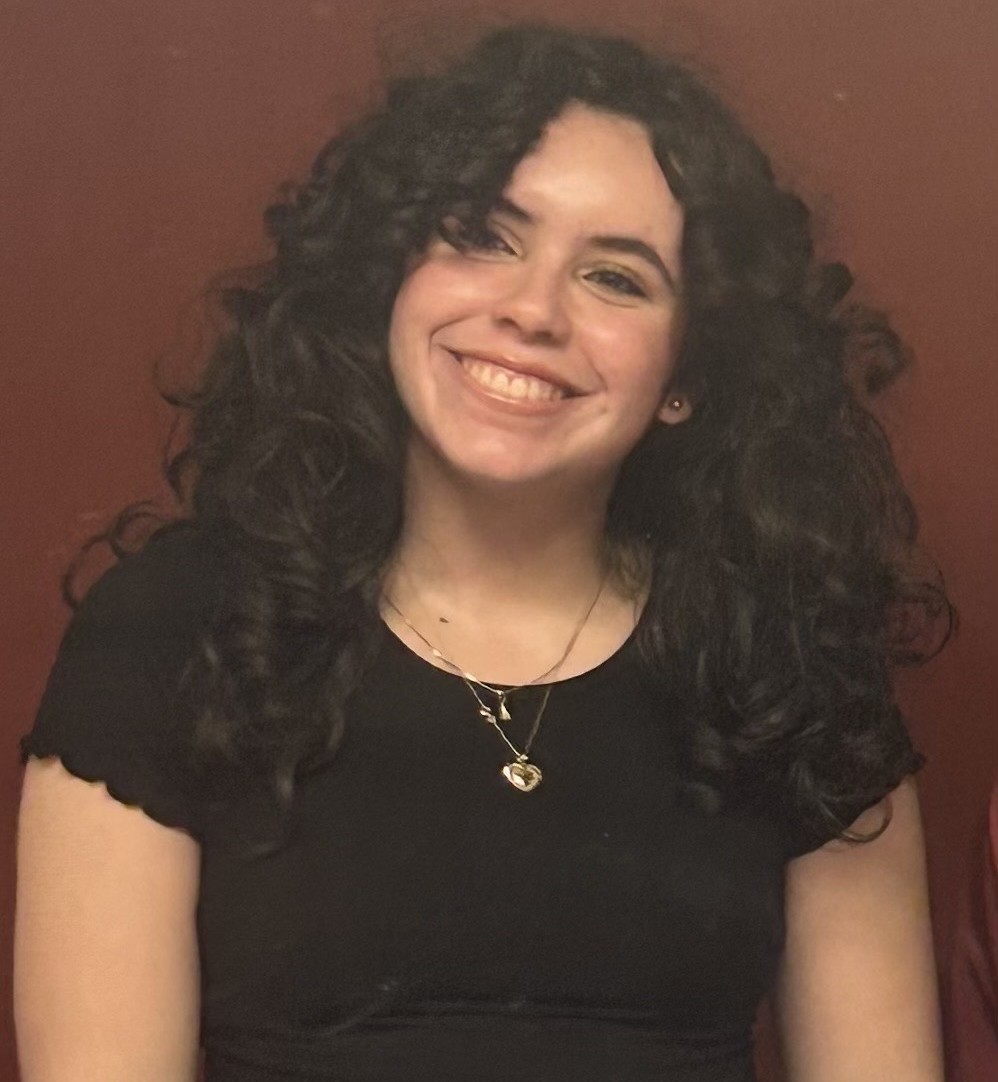
BIO
My name is Adria Morales Santiago, and I am a second-year student at Florida State University, majoring in Biological Sciences. Originally from Cuba, I moved to Naples, FL, in 2019. In addition to my academic work, I enjoy reading and spending time with my friends and family. I am passionate about the research I am involved in FSU and plan to pursue medical school after graduation to become a surgical oncologist or an oncologist.
Sturgeon-Derived Peptide LLLE Reduced Colitis by Regulating Gut Microbiota and Metabolites
Authors: Adria Morales Santiago, Dr. Quancai SunStudent Major: Biological Sciences
Mentor: Dr. Quancai Sun
Mentor's Department: Health, Nutrition, and Food Sciences Mentor's College: Anne Spencer Daves College of Education, Health, and Human Sciences Co-Presenters:
Abstract
Inflammatory bowel disease (IBD), which includes ulcerative colitis (UC) and Crohn's disease, is characterized by chronic inflammation of the gastrointestinal tract. The causes of IBD are multifactorial, influenced by genetic predisposition, changes in the gut microbiome, and immune system dysfunction, which contribute to its increasing prevalence worldwide. Recent research has identified a peptide derived from sturgeon that demonstrates significant anti-inflammatory properties, offering a potential therapeutic strategy for managing IBD symptoms. This study evaluates the efficacy of the sturgeon-derived peptide LLLE (Leu-Leu-Leu-Glu) in reducing inflammation and restoring gut homeostasis in a mouse model of colitis induced by dextran sulfate sodium (DSS). The findings indicate that LLLE treatment effectively reduced weight loss and improved disease activity index (DAI) scores in mice with DSS-induced colitis. Histological analysis revealed that LLLE treatment enhanced colon structural integrity, diminished tissue damage, and lowered levels of interleukin-6 (IL-6), a key inflammation marker. Moreover, 16S rRNA sequencing showed that LLLE modulated the gut microbiota by decreasing the DSS-induced increase in Bacteroidetes. A fecal metabolite analysis indicated that LLLE helped restore metabolites, such as indole-3-propionic acid, known for its anti-inflammatory effects. Future investigations may involve a comparative analysis of the effects of the sturgeon peptide in female versus male mice, as this study exclusively used male subjects. In summary, these findings suggest that the sturgeon-derived peptide has promise as a therapeutic intervention for colitis, potentially reducing inflammation, restoring gut microbiota balance, and replenishing essential metabolites.
Keywords: Inflammatory Bowel Disease, gut microbiota, metabolomics.
25th annual Undergraduate Research Symposium, April 1, 2025
Hannah Barron Poster Session 1: 9:30 am - 10:30 am / Poster #2
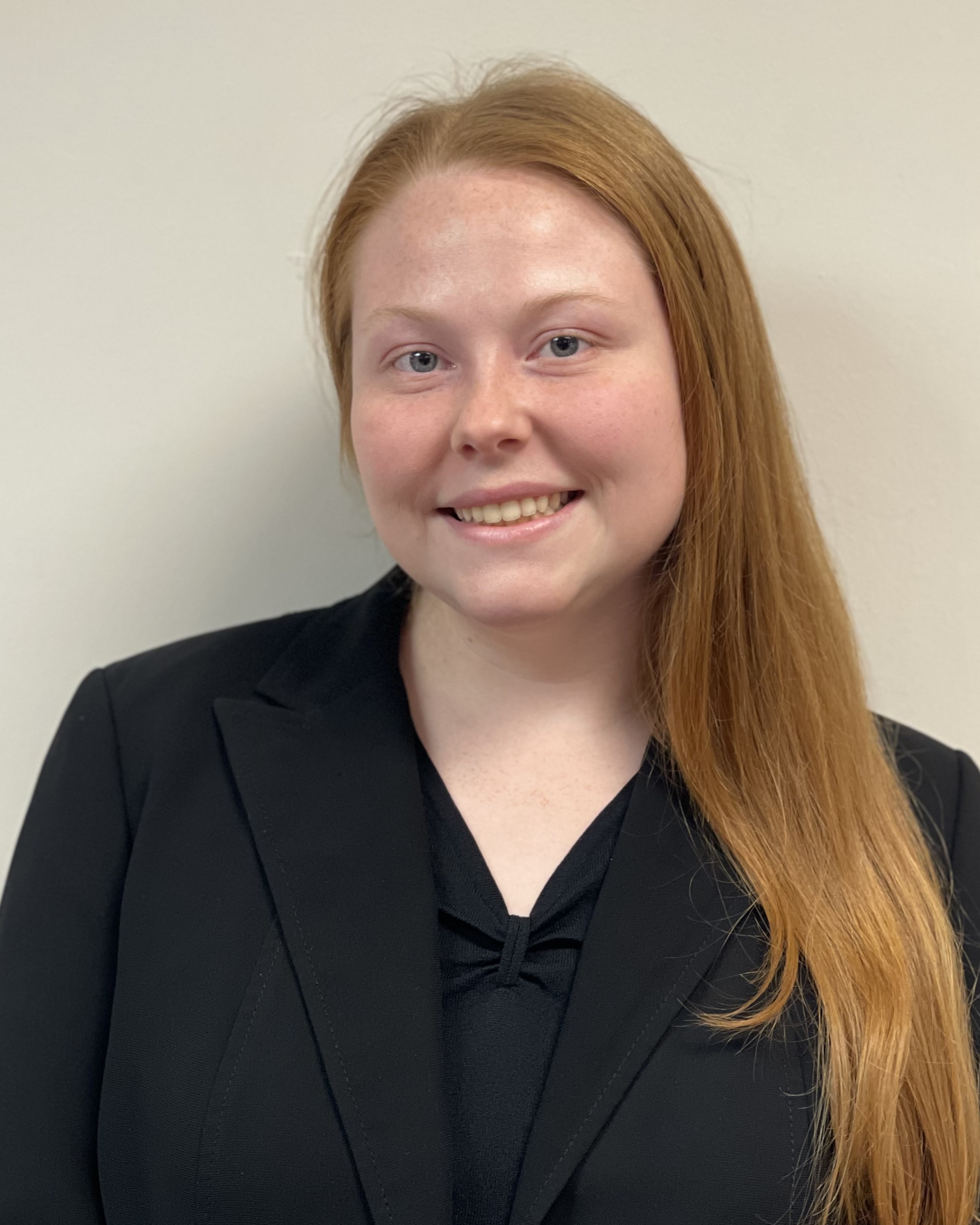
BIO
Hello, my name is Hannah Barron, and I am from Palmetto, FL. I am currently pursuing a degree in neuroscience on a pre-med track with a particular interest in neuropsychology, aspiring to become a psychiatrist. I have a passion for reading, learning new things, and spending time with friends.
For the past year, I have had the privilege of working with Dr. Kuang, conducting research on AI attitudes and perceptions over the past five months. This experience has provided me with valuable insights into the world of research.
AI: Friend, Foe, or Future? A Review of Attitudes and Perceptions of AI
Authors: Hannah Barron, Dr. Hailey KuangStudent Major: Behavioral Neuroscience
Mentor: Dr. Hailey Kuang
Mentor's Department: Department of Educational Psychology & Learning Systems Mentor's College: Anne Spencer Daves College of Education, Health, and Human Sciences Co-Presenters: Alden Vega
Abstract
This project explores the demographic factors associated with individuals' attitudes and
understanding of Artificial Intelligence (AI) through a literature review. We searched for
relevant studies using keywords such as "AI trust," "AI attitudes," and "AI anxiety." After
applying inclusion and exclusion criteria, we identified the five most relevant papers. The
findings indicate that age, gender, and educational background are key demographic
factors linked to AI attitudes. For example, Schepman and Rodway (2022) found that
men and younger individuals tend to hold more positive views of AI. By highlighting these
demographic trends, our review underscores the need to account for these factors when
developing surveys and conducting further research into public perceptions of AI.
Keywords: AI, Undergrad, Psychology, Opinion, Review, Artificial Intelligence
25th annual Undergraduate Research Symposium, April 1, 2025
Sreeja Patnala Poster Session 4: 3:00 pm - 4:00 pm/ Poster #273

BIO
Hello! My name is Sreeja Patnala and I am currently on the pre-med track, planning to graduate as the class of 2027. My hometown is South Florida and I have a twin brother who attends FSU along my side. I love learning and designing new discoveries to shape our planet into a better home for everyone. I am very intrigued and passionate about research on a variety of subjects related to cognition, biomedicine, and technology.
Developing a Trustworthy AI Chatbot for Personalized HIV Care
Authors: Sreeja Patnala, Dr. Ruosi ShaoStudent Major: Biological Science
Mentor: Dr. Ruosi Shao
Mentor's Department: School of Communication Mentor's College: College of Communication and Information Co-Presenters: Shiv Patel
Abstract
People with HIV (PWH) face persistent barriers to optimal care, including challenges with antiretroviral therapy (ART) adherence, retention in care, and engagement with preventive health services. These barriers disproportionately affect minoritized populations and contribute to disparities in viral suppression and overall health outcomes. Digital health interventions, such as conversational agents (CAs) or chatbots, offer a scalable and accessible means to support PWH across the HIV care continuum by providing personalized, real-time health guidance
To address these challenges, we developed a personalized, AI-powered chatbot—Aipaca—designed to deliver real-time, evidence-based HIV care guidance. Leveraging Large Language Models (LLMs), our chatbot integrates clinically validated recommendations to enhance the accessibility, accuracy, and inclusivity of HIV support.
To fine-tune the AI, we curated a comprehensive HIV Knowledge Bank covering the full continuum of HIV care. This included over 1,080 pages of peer-reviewed material, 450 quiz questions, and 1.2 million tokens of synthesized content. We benchmarked both open-source (Llama, Mistral) and closed-source (GPT-4, Gemini) LLMs on clinical accuracy, reasoning, and patient-centered communication. Preliminary results demonstrate the feasibility of using AI chatbots to provide personalized care, including support for mental health, medication safety, and HIV prevention strategies such as PrEP.
Ongoing efforts include expert interviews to refine clinical applicability, pilot testing with PWH, and performance validation to ensure the chatbot’s safety, accuracy, and scalability in real-world healthcare settings. Our findings highlight the potential of AI chatbots to transform HIV care by offering personalized, accessible, and trustworthy support for PWH.
Keywords: Artificial Intelligence (AI), Virtual Reality (VR), Human Immunodeficiency Virus (HIV), Healthcare, and mobile health (mHealth)
25th annual Undergraduate Research Symposium, April 1, 2025
Katie Baldwin Poster Session 2: 10:45 am - 11:45 am/ Poster #5
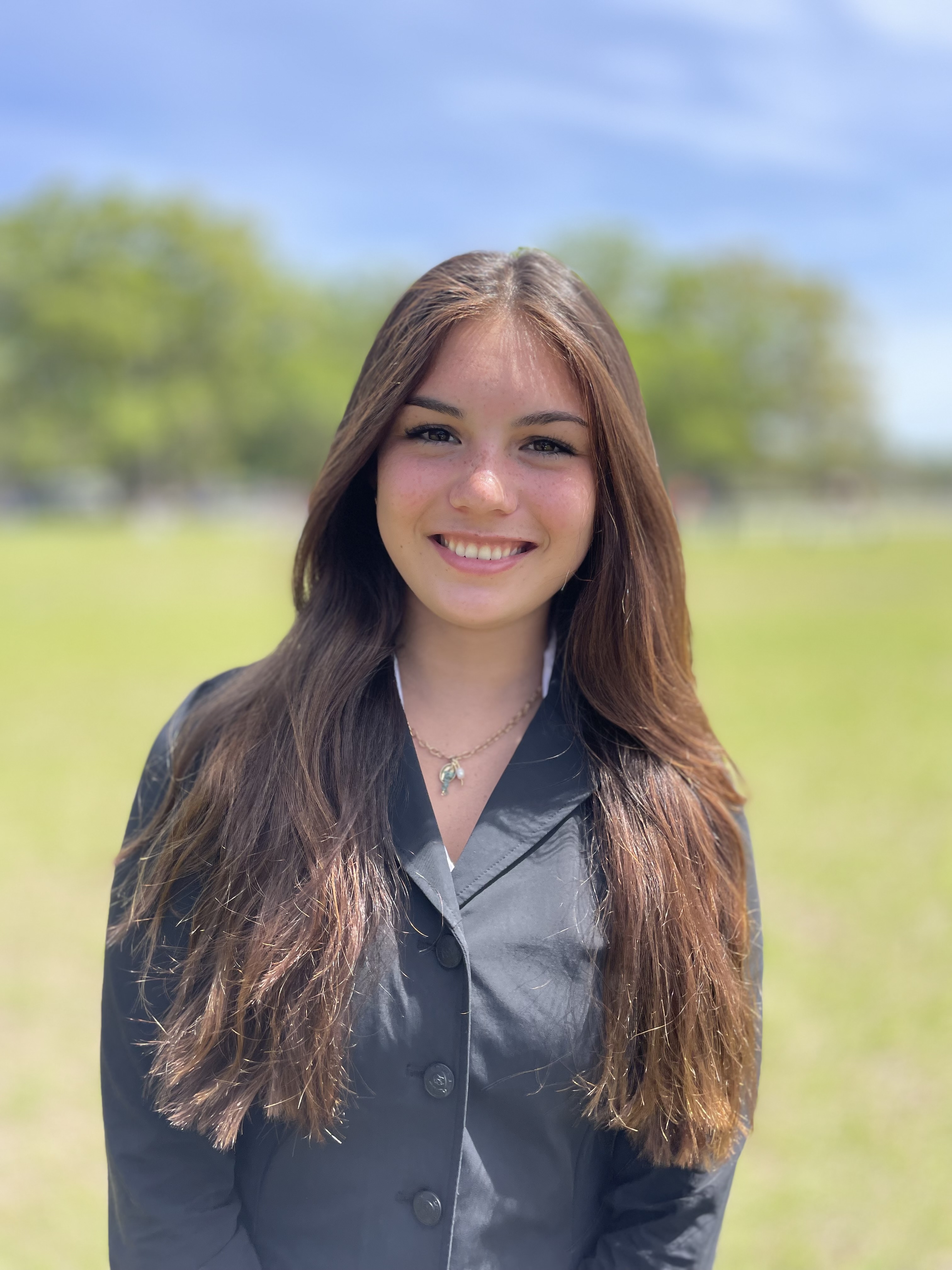
BIO
Ms. Katie Baldwin is a freshman at Florida State University majoring in Finance with a minor in Psychology. Originally from Stuart, Florida, she earned my Associate in Arts degree from Indian River State College before graduating from Clark Advanced Learning Center.
At FSU, she participates in the Undergraduate Research Opportunity Program to develop her scholarly capacity as a research assistant by contributing to the National descriptive database on Collegiate Recovery Programs funded by the Association of Recovery in Higher Education. To further facilitate her professional development, Ms. Baldwin is also a member of the Business Case Club where she improves her ability to competitively and effectively deliver a business case. Promoting her personal passions, she further participates in the FSU Equestrian Club, competing in dressage across Region J.
Katie is deeply passionate about finance, psychology, and personal growth and looks forward to her time at Florida State University as a vital period for cultivating her intellectual interests and abilities into a meaningful career of service in her community.
Descriptive Database on Collegiate Recovery Program
Authors: Katie Baldwin, Dr. Chelsea ShoreStudent Major: Finance minor Psychology
Mentor: Dr. Chelsea Shore
Mentor's Department: Department of Educational Leadership and Policy Studies Mentor's College: Florida State University Co-Presenters: Ava Arch, Zikora Aliche, Emily Arredondo
Abstract
This descriptive database is meant to improve the landscape of resources available concerning Collegiate Recovery Programs (CRPs). By creating this descriptive database, there are vetted research studies on ways to better impact CRPs. Vest et al. (2021) conducted a systematic search of articles related to collegiate recovery programming published before August 2020. The 15 extracted study characteristics included publication type, study design, primary outcomes, reporting of behavioral addictions, mutual-help group attendance, sample demographic information, school size, ownership, and funding source. The PRISMA-guided search strategy identified 357 articles for abstract review; of 113 articles retained for full-text review, 54 studies met criteria for inclusion. Primary outcomes were coded into four domains: clinical, recovery experience, program characterization, and stigma. Most (57%) used quantitative observational designs and 41% employed qualitative research designs. Government or foundation grants funded 11% of the studies.
Keywords: Collegiate Recovery Programs (CRPs), Mental Health, Addiction, Substance Use, Database
25th annual Undergraduate Research Symposium, April 1, 2025
Mia Parker Poster Session 2: 10:45 am - 11:45 am/ Poster #190

BIO
My name is Mia Parker, and I am a second-year undergraduate student from Orlando, FL, majoring in Cell & Molecular Neuroscience at Florida State University. I am on the pre-medicine track, with aspirations of pursuing a career in dermatology, where I hope to integrate clinical practice with research to advance patient care.I have developed a strong foundation in scientific inquiry and laboratory techniques through my coursework and research experience, including my involvement in the Undergraduate Research Opportunity Program (UROP). I am eager to continue expanding my research experience throughout my undergraduate career, focusing on areas such as neurocognitive diseases this summer. Beyond UROP, I am involved with Tallahassee Memorial Healthcare as a Clinical College Associate Volunteer where I assisted nurses with patient care.
Emerging Adults Experiences with Frustration in Dating
Authors: Mia Parker, Ava Joy CockeyStudent Major: Cell & Molecular Neuroscience
Mentor: Ava Joy Cockey
Mentor's Department: Human Development & Human Sciences Mentor's College: Health and Human Sciences Co-Presenters: Adrian DeLeon
Abstract
This study investigates the relationship between frustration and dating experiences to develop a scale for measuring dating related frustration. To do this, we must also understand other emotions such as loneliness and rejection. By addressing this gap, the research provides information that may improve dating experiences.
The study used a self-report survey consisted of questions. Data was collected at two points assessing how experiences changed over time. Necessary research tasks included study advertisement and participant recruitment.
Preliminary results are expected to reveal relationships between frustration in dating and feelings of loneliness. This information will help develop a frustration scale and provide data for future research.
Keywords: psychology, dating, frustration
25th annual Undergraduate Research Symposium, April 1, 2025
Kaylen Burgess Poster Session 3: 1:45 pm - 2:45 pm/ Poster #2
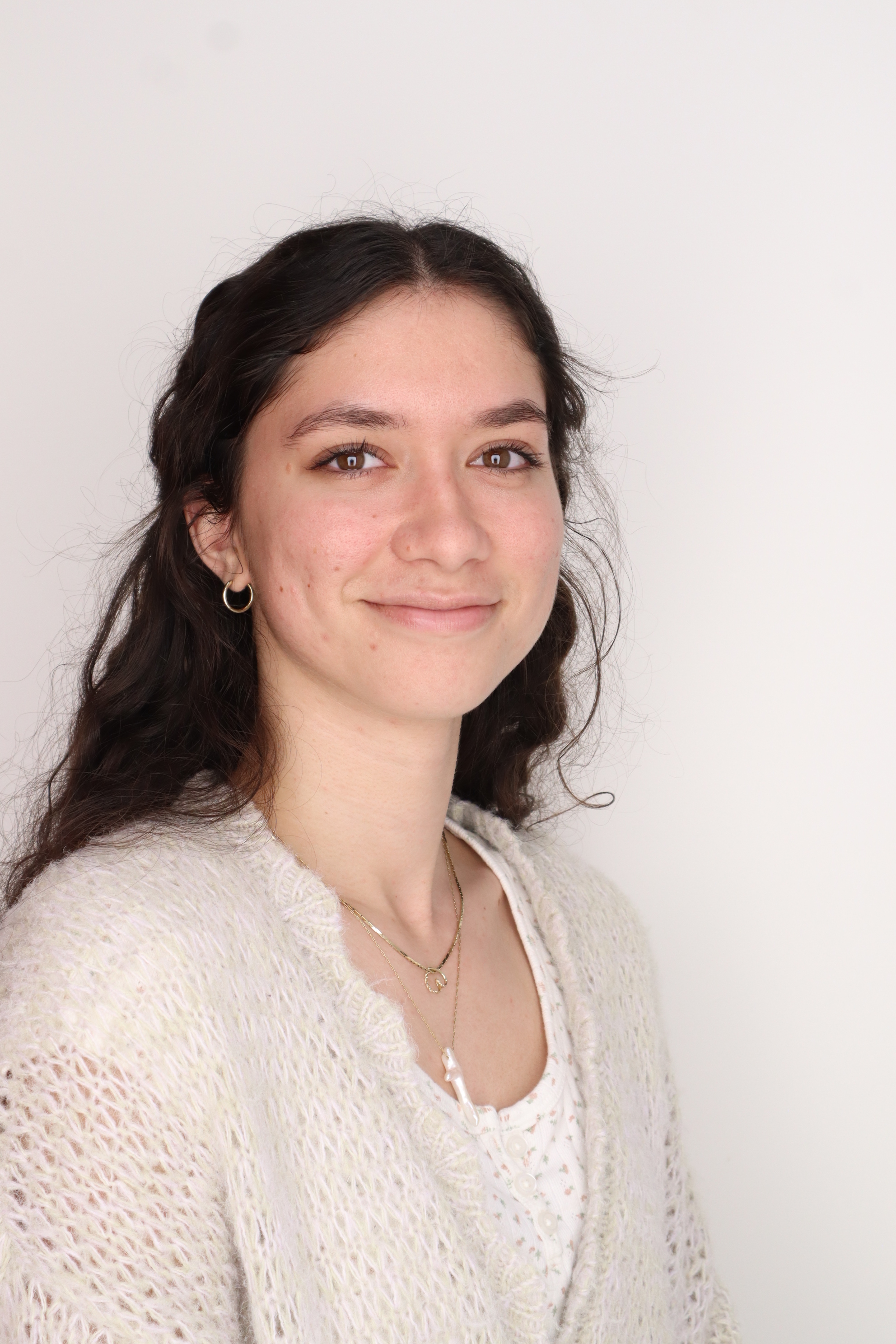
BIO
I am a second year undergraduate student here at FSU majoring in biology on the pre-health track. I plan on becoming a physical therapist specializing in pediatrics and/or oncology. I am interested in rehabilitative medicine, environmental sciences, and health overall.
From Roots to Results: Exploring Early Childhood Teachers’ Journeys Through a Farm-to-School Training Program
Authors: Kaylen Burgess, Camille LewisStudent Major: Biological Sciences
Mentor: Camille Lewis
Mentor's Department: Educational Psychology: Learning and Cognition Mentor's College: Anne's College of Education, Health, and Human Sciences Co-Presenters: Avery Karl
Abstract
Childhood obesity is a pervasive health problem in the United States that persists despite national efforts to combat it. This is largely due to a lack of fruits and vegetables in children’s diets. Farm-to-School Programs have been created to attempt to remedy this lack of nutrition and introduce students to gardening practices. This study explores the impact of a six-month professional development program on early childhood educators’ self-efficacy and knowledge in implementing Farm-to-School initiatives. This study addresses gaps in the current literature by assessing the effects of professional development training on the longevity of school gardening initiatives. A qualitative, single-case research design was utilized. A farm-to-school training program was implemented among early childhood educators at the Early Childhood Center for Excellence. This consisted of gardening classes, on-going modeling, and farm-to-school coordination. Data was collected in focus groups, semi-structured interviews, and observations. Data analysis is currently underway, but preliminary results highlight several key themes. First, professional development programs can drive meaningful personal and professional growth among educators. Second, institutional support is essential for successful implementation of a farm-to-school program. Finally, formal and informal reflective dialogue plays a pivotal role in inspiring innovative teaching practices and fostering deeper connections between educators and garden-based learning. This study highlights the importance of institutional support, such as dedicated planning time, and provides insights for the creation of teacher training programs. Future research can be conducted within educational policy to determine how policy creators’ self-efficacy regarding gardening practices relates to the implementation of educational policies.
Keywords: farm-to-school, child development, nutrition
25th annual Undergraduate Research Symposium, April 1, 2025
Kiera Powers Poster Session 2: 10:45 am - 11:45 am/ Poster #178
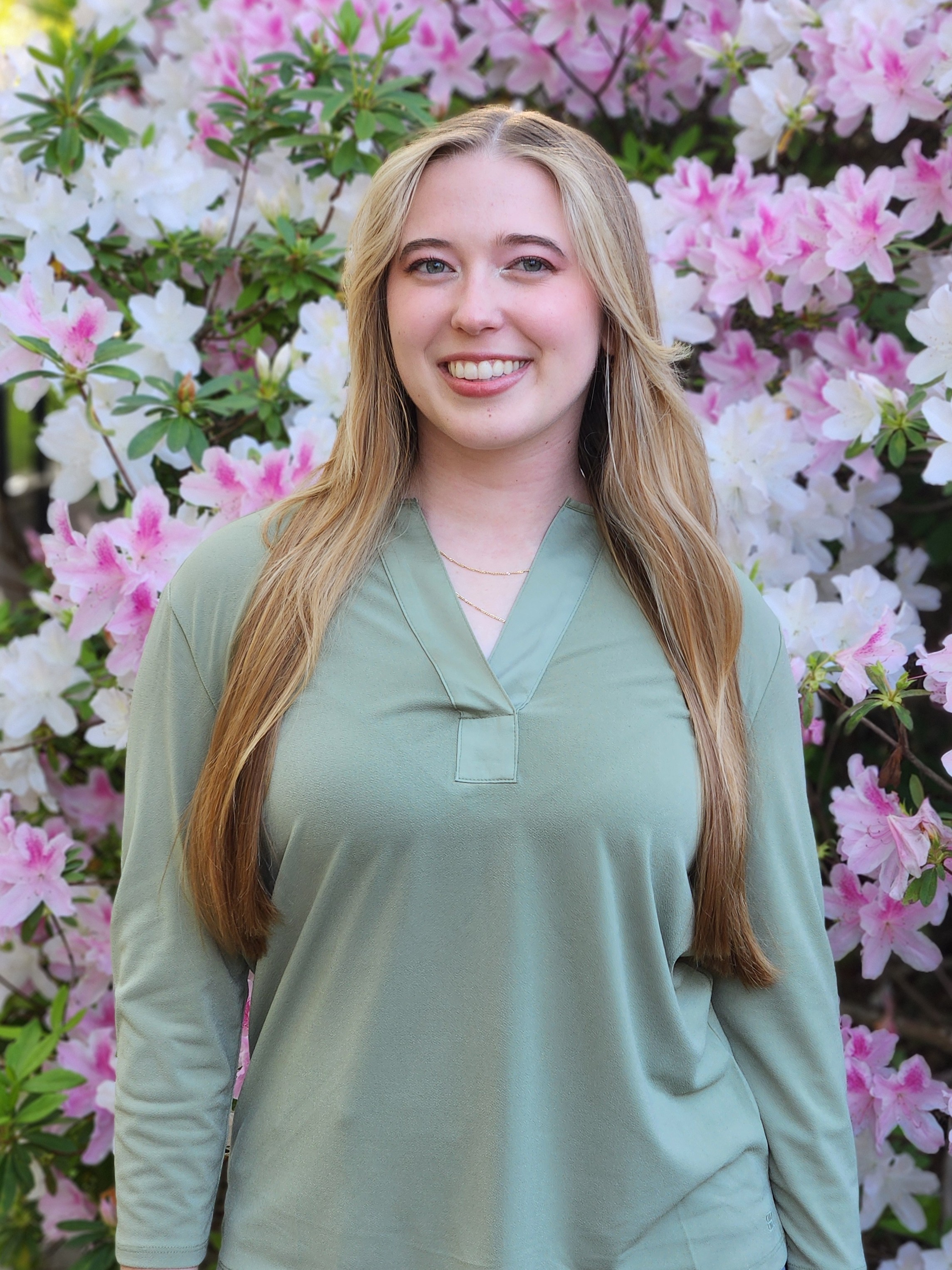
BIO
My name is Kiera Powers, a second year at FSU from Sarasota, Florida, working toward a bachelor’s degree in chemistry. Following the completion of my undergraduate studies, I aim to obtain a PhD in chemistry and hope to establish a career specializing in either Nuclear or Materials chemistry.
Spin Density Distribution in Organic Biradicals
Authors: Kiera Powers, Tomas OrlandoStudent Major: Chemistry
Mentor: Tomas Orlando
Mentor's Department: Electron Magnetic Resonance Mentor's College: National Magnetic Field Laboratory Co-Presenters: Not Applicable
Abstract
Organic biradicals are molecules with two unpaired electrons. Researchers use molecules like these for spin polarization transfer, a technique that lines up all electrons in a molecule in one direction. Molecules with similar properties are used in magnetic resonance imaging, quantum sensing, and as catalysts. The organic biradicals in this study are very large, made of hundreds of atoms. As a result, their electron paramagnetic resonance (EPR) spectra are very forested, with complicated hyperfine splitting patterns that make them difficult to analyze. Our goal is to reproduce their spectra through simulation. The three molecules analyzed in this study differ only by their carbon-carbon bridge connecting the two radicals. The first molecule has a bridge consisting of a carbon triple bond; the second contains a bridge double the length, with two carbon-carbon triple bonds; the third has no bridge, and the two radicals are connected with aromatic rings. The purpose of this study is to find the hyperfine couplings in order to understand the spin systems of each molecule and the differences between them. To this aim, we used quantum chemistry calculations to compute the molecular and electronic structure, estimate the electron-nuclear hyperfine coupling, and simulate the EPR spectrum. Our simulations do not fully reproduce the experimental results, meaning that the exact spin systems of these molecules remain difficult to reproduce with the current computational tools.
Keywords: Chemistry, EPR, Spin, Organic Radical, Hyperfine, Magnetic Resonance
25th annual Undergraduate Research Symposium, April 1, 2025
Madison Jones Poster Session 1: 9:30 am - 10:30 am/ Poster #179

BIO
Madison Jones is a second-year student from Miami, FL, currently pursuing a pre-med track. She is actively gaining hands-on experience as a medical assistant intern, where she can apply her passion for healthcare in a clinical setting. Madison is also a member of the Phi Mu Fraternity. She loves to embroider and sew in her free time. With a strong commitment to her future medical career, Madison is eager to explore new research opportunities and further expand her knowledge in the medical field.
Smart Clothing for Monitoring Breastfeeding Care
Authors: Madison Jones, Professor Te-Yen WuStudent Major: Biological Science
Mentor: Professor Te-Yen Wu
Mentor's Department: Computer Science Mentor's College: College of Arts and Sciences Co-Presenters:
Abstract
The most efficient way to nourish an infant is exclusive breastfeeding during the first six months. Because of an infant’s reliance and the repetitive timing of breastfeeding, several health factors can be revealed. These may include an infant’s suck/breathe/swallow ratio, infant heart rate, and nutritive sucking versus non-nutritive sucking. This experiment encompasses what metrics should be measured during breastfeeding. This is demonstrated through the production of a smart clothing garment, worn by a breastfeeding mother. For monitoring the infant’s suck/breathe/swallow ratio, the garment will have a non-contact microphone. The garment includes electrodes that capture the mixed electrocardiogram signals between the mother and infant’s heart rate. Through using OpenBCI Cyton Board, these two signals have been isolated at a 98.7% accuracy. Completed wear tests with mothers and infants will expand upon the current scope of infant vitals while feeding. Increased insight in this domain can be crucial to early recognition of infant health, including, but not limited to: congenital heart defects, issues within oral structure, and lung disease.
Keywords: Smart Garment Kangaroo Breastfeeding Medical
25th annual Undergraduate Research Symposium, April 1, 2025
Jasmine Grant Sutton Poster Session 1: 9:30 am - 10:30 am/ Poster #128
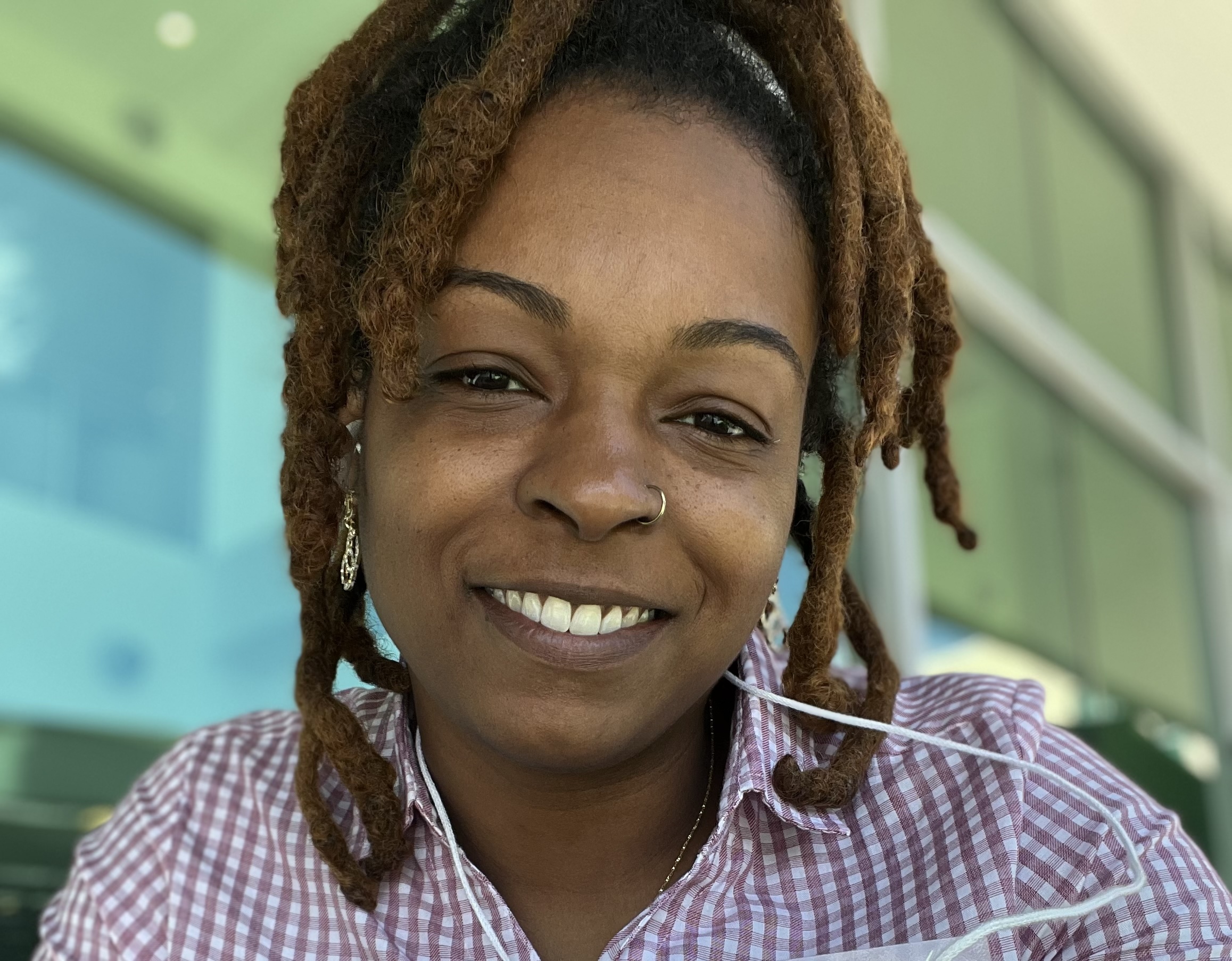
BIO
I am a dedicated student, mother of three, and passionate advocate for storytelling and cultural representation. At 34, I am pursuing a degree in Humanities with concentrations in Communications, Digital Communications, and African American Studies. My academic journey is driven by a deep interest in media, history, and the power of communication to shape narratives. Balancing motherhood and education, I am committed to using my studies to amplify underrepresented voices and contribute to meaningful discussions on race, culture, and digital media. With aspirations to work in media, I hope to create impactful content that informs, inspires, and uplifts communities.
Empowering Marginalized Youth Through Sports: Developing Marketing and Brand Strategies for Community-Based Athletic Programs and Media Engagement
Authors: Jasmine Grant Sutton, Ruosi ShaoStudent Major: Humanities with Concentrations in Communications, Digital Communications, and African American Studies
Mentor: Ruosi Shao
Mentor's Department: Communications Mentor's College: Communications Co-Presenters:
Abstract
While they promote social resilience, lower recidivism, and promote personal growth, community-based sports programs have the power to change the lives of marginalized youth. Despite these advantages, a lot of these initiatives have trouble obtaining funding, recognition, and ongoing community support. This study looks into the best ways to sell these programs to increase their impact using brand building and strategic marketing, which are based on popular sports networks like ESPN.
The study looks at audience engagement tactics, digital storytelling approaches, and branding strategies employed by top sports media in order to solve this. Key components that support the successful promotion and long-term viability of youth sports programs are identified through qualitative case studies and interviews with program organizers, marketing experts, and participants.
According to preliminary research, sports programs can greatly increase their reach and efficacy by utilizing digital media, establishing alliances with nearby companies, and developing narratives that emphasize their social benefit.
The study offers a number of ramifications and potential research directions that could have significant effects on sports marketing, youth empowerment, and community development. The media's role in youth development, the social impact of sports marketing, and the development of economic and policy are only a few of the implications. Investigating issues like: How can strategic marketing and brand development, inspired by successful sports networks like ESPN, be leveraged to create and promote community-based athletic programs that empower margenalized youth and foster positive social outcomes? can allow for more research on the topic. Let us empower all.
Keywords: Empowering Marginalized Youth
25th annual Undergraduate Research Symposium, April 1, 2025
Judith Ortega Poster Session 3: 1:45 pm - 2:45 pm/ Poster #132
BIO
Hello! My name is Judith Ortega, and I am a first-generation, second-year student majoring in Media Communication with a minor in Hispanic Marketing at Florida State University. During my time at FSU, I plan to enhance my professional skills and develop a strong networking community. My goal is to pursue higher education while working in the entertainment industry.
Examining the Country of Origin (COO) Effect on Consumer Perception and Purchasing Behavior of Mexican Small Business and Artisanal Products
Authors: Judith Ortega, Dr. Sindy ChapaStudent Major: Media- Communication
Mentor: Dr. Sindy Chapa
Mentor's Department: College of Communication and Information Mentor's College: Center for Hispanic Marketing Communication Co-Presenters:
Abstract
This study examines the extent to which the country of origin (COO) effect influences consumer perceptions of products from small Mexican businesses, such as tequila, mezcal, and Talavera pottery, in both Mexico and the United States. It analyzes how Mexican consumers perceive their own products compared to American consumers and how these perceptions impact their purchase intentions. The COO effect, introduced by Britain in 1887, refers to the perception of a product’s origin based on its branding, packaging, or labeling, shaping expectations regarding quality, reliability, and value (Nagashima, 1970; Papadopoulos & Heslop, 1993). This study reviews recent literature on the COO effect, assessing the reliability and validity of previous findings and examining the constructs used to measure COO’s influence on consumer attitudes and behaviors toward Mexican-made artisanal goods. A pilot test identifies and validates the COO scale, followed by data collection in Mexico and the United States to gain deeper insights into consumer perceptions and purchasing behaviors. The findings provide valuable implications for businesses, particularly in the marketing and positioning of Mexican products. Understanding the role of COO in shaping consumer preferences helps small businesses develop effective branding strategies, improve market positioning, and enhance consumer trust, ultimately influencing purchasing decisions and business success in both domestic and international markets.
Keywords: COO, Mexican Artisanal, Judith
25th annual Undergraduate Research Symposium, April 1, 2025
Kellan Kissinger Poster Session 3: 1:45 pm - 2:45 pm/ Poster #152
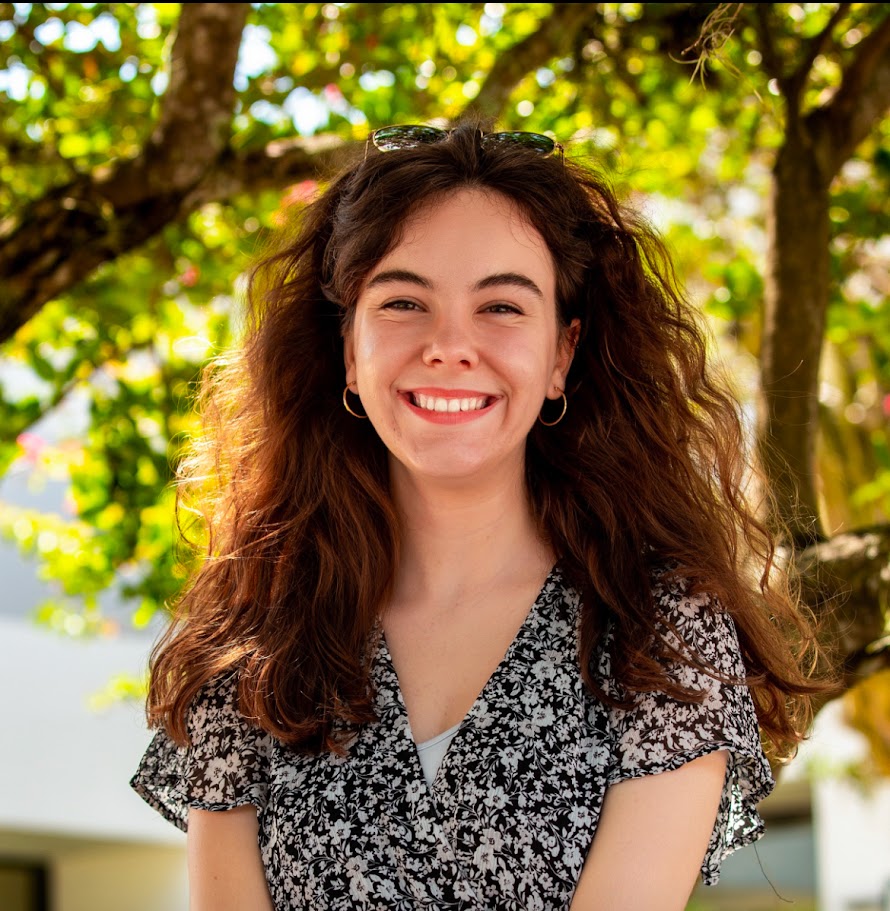
BIO
Hello! I am a second year majoring in English from Safety Harbor, FL. My interest in this topic of research largely stems from my position as an aftercare instructor at a local Tallahassee K-8 school. I look forward to learning more about the education sphere and nontraditional methods of learning. In addition to my UROP research and participation, I am also a member of the University Honors program, a Service Scholar with the Center for Leadership and Service, and an IDEA Grant recipient for an Honors in the Major thesis that aims to trace female utopianism through medieval and contemporary literature.
Merging Museum & Classroom: Museum Education as a Teacher’s Pedagogy
Authors: Kellan Kissinger, Audrey JacobsStudent Major: English (Editing, Writing, & Media); Minor in Philosophy & Law
Mentor: Audrey Jacobs
Mentor's Department: Department of Art Education Mentor's College: College of Fine Arts Co-Presenters:
Abstract
Museum school model of education is a nontraditional learning program that combines the customizability of a typical K-12 classroom setting with the innovation, immersive, and engaging methods of a museum environment. To investigate this type of schooling, this project asks the following question: How does an individual museum schoolteacher strive to bring museums into the teaching process? To further investigate this question, an interview with a middle school teacher was transcribed and coding following grounded theory. This process highlights key terms and processes museum educators use in museum education from their first-hand experiences. Then, this coding was used to create a visual model of how museum education generally occurs and develops. The categories of the model include the processes of customizing learning to students, working within operation cultures, and many others. These categories can be used to inform museum school programs so that teachers and museum staff can combine the strengths of traditional classroom learning and non-traditional museum learning to further engage future students. Further research could investigate the role of museum liaisons and the importance of external partnerships, such as field trip destinations, in the museum schooling sphere.
Keywords: Museum Education, Grounded Theory, Education, Learning


